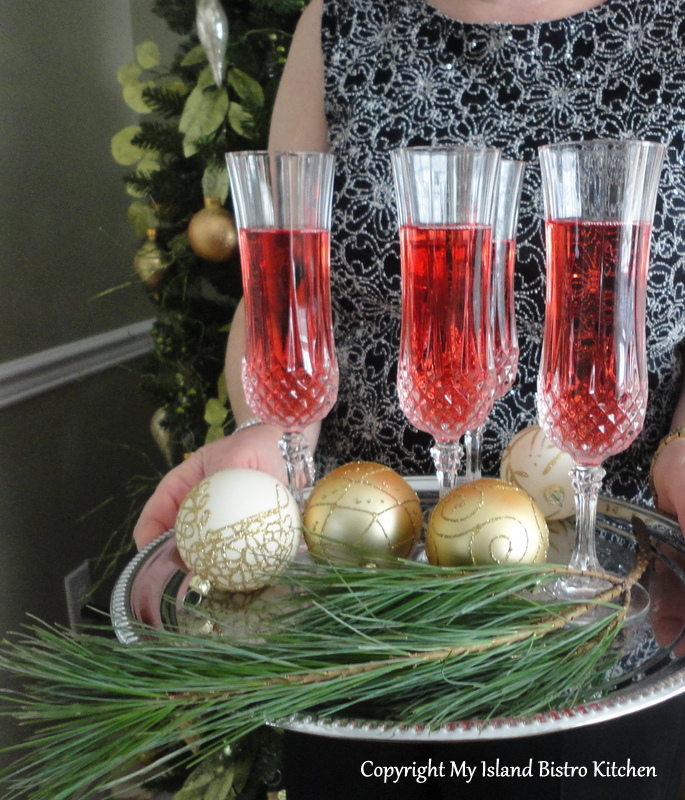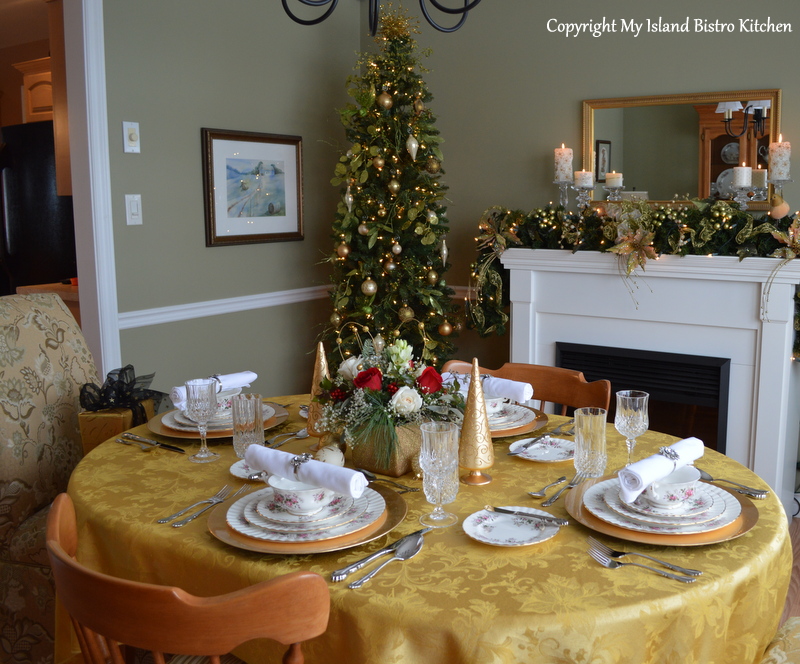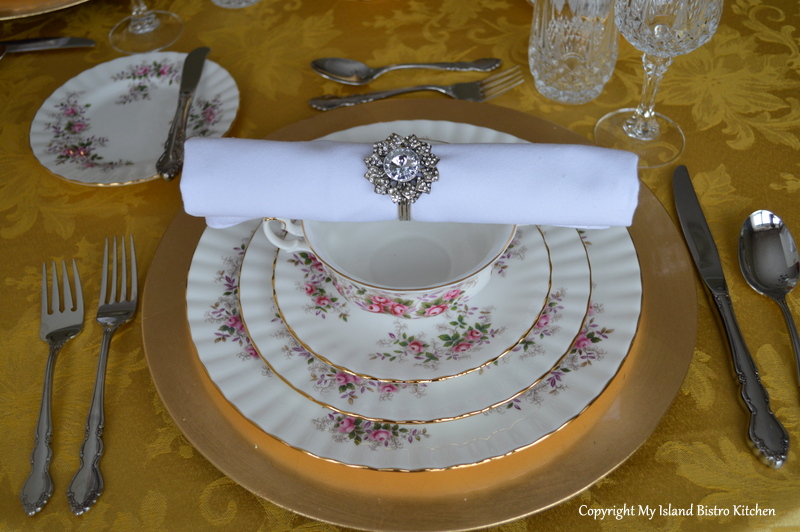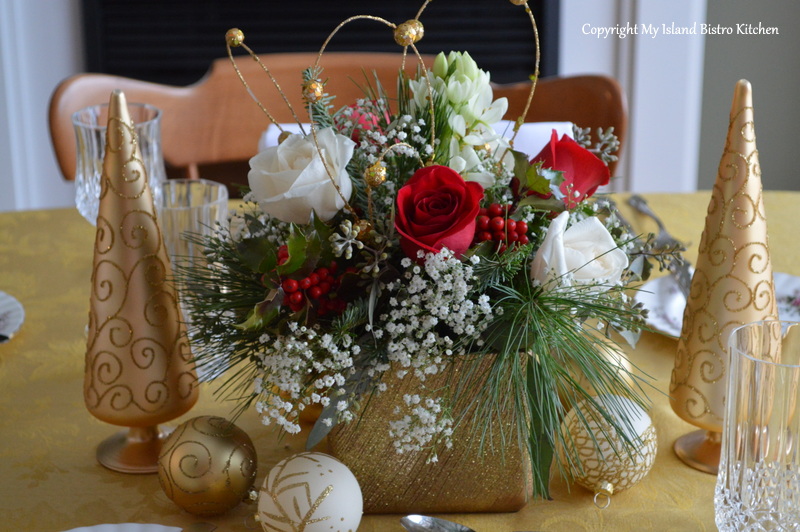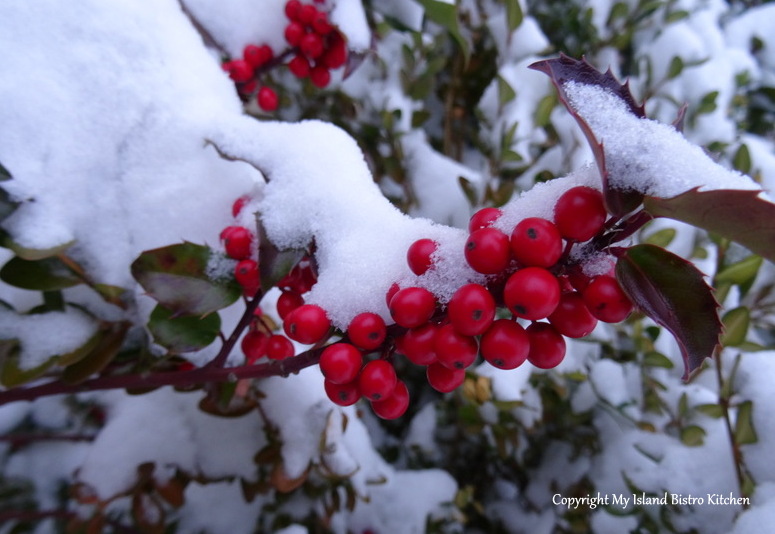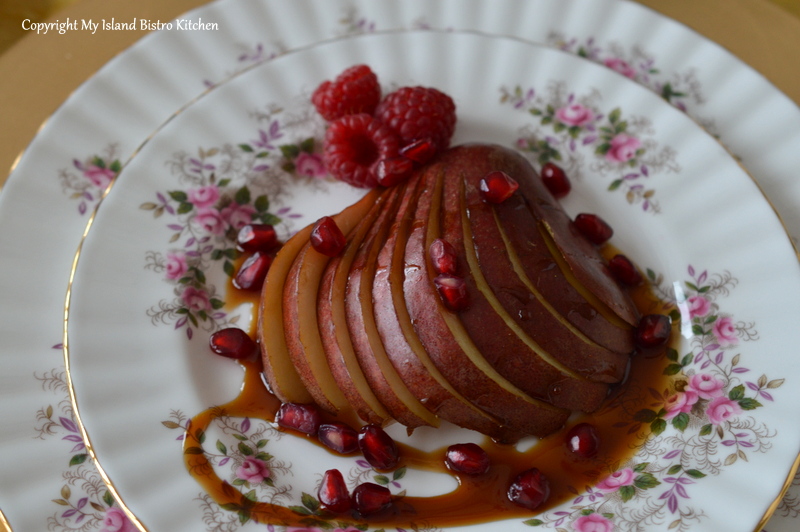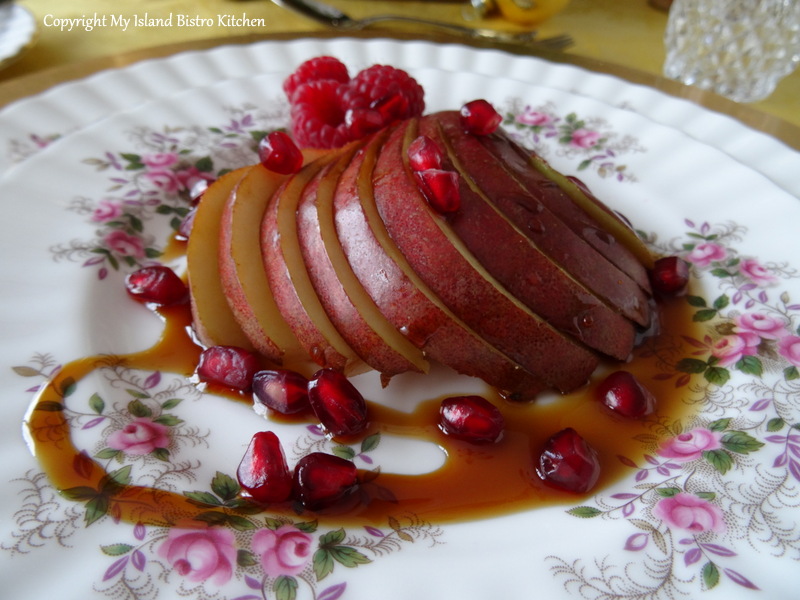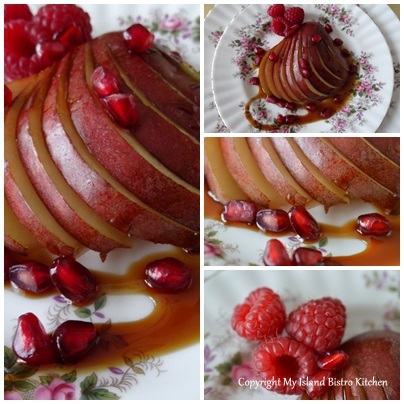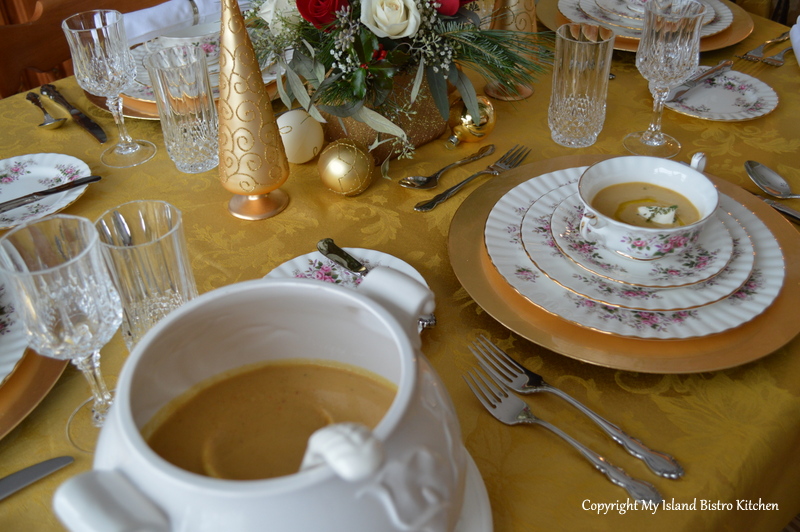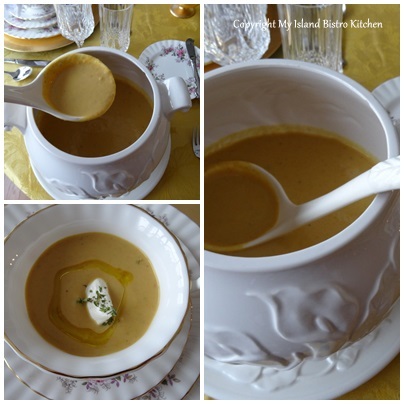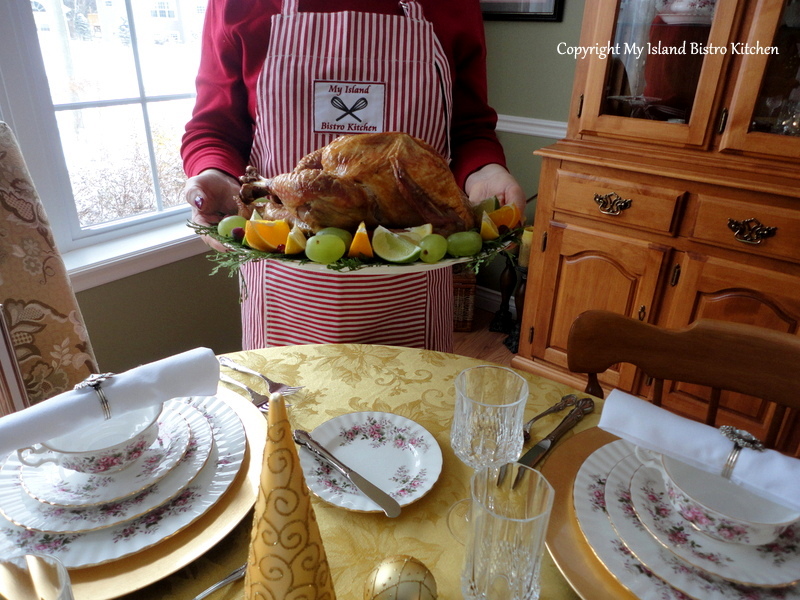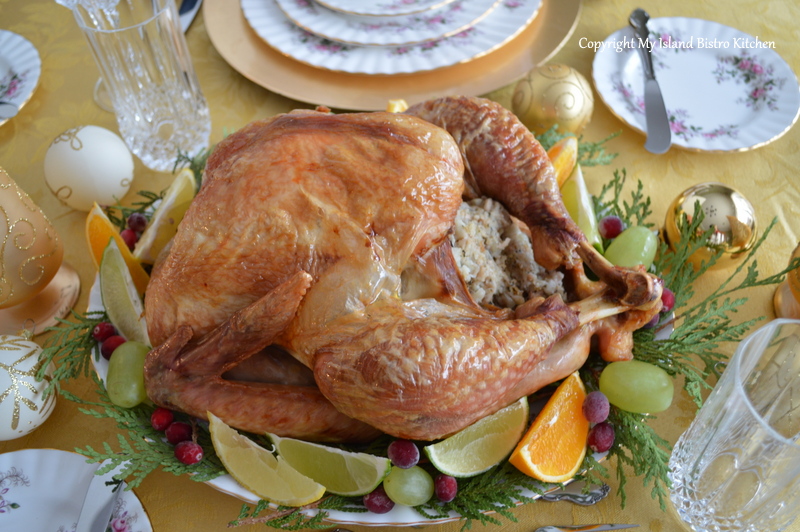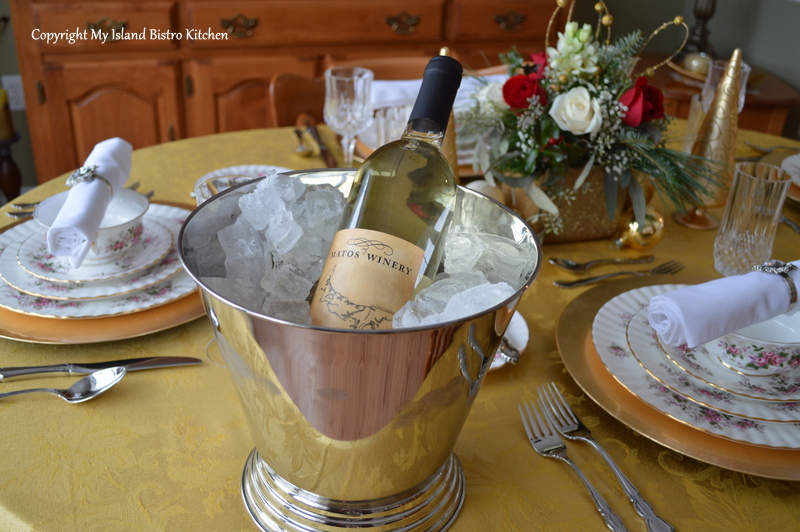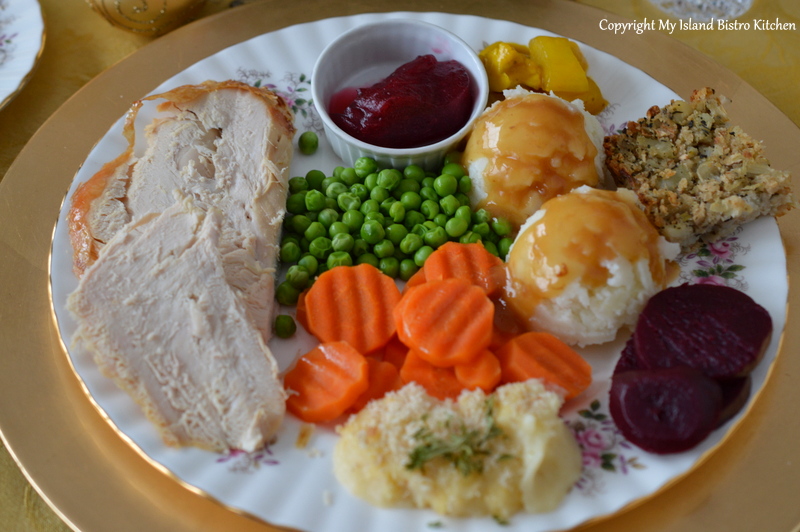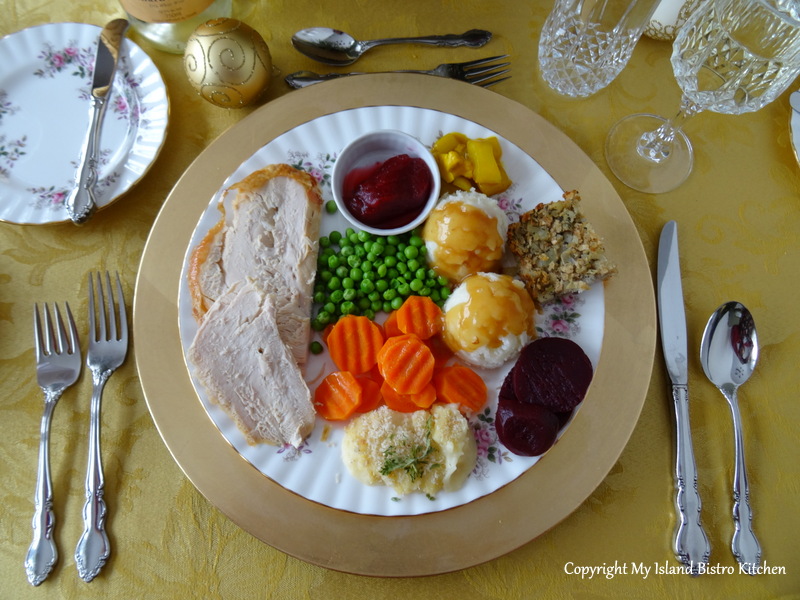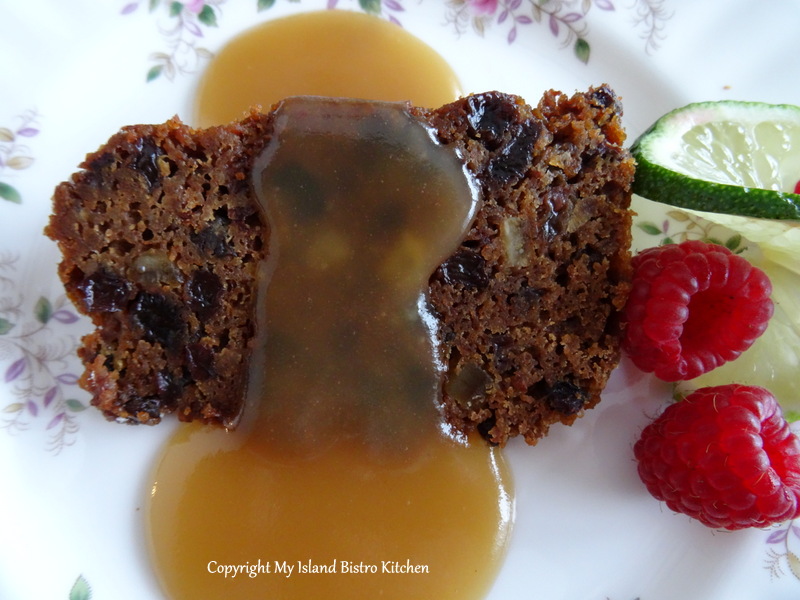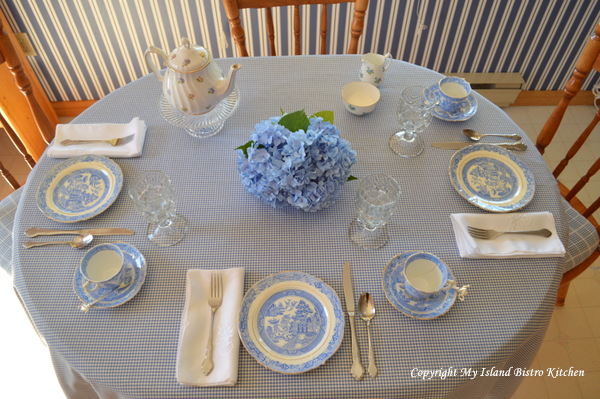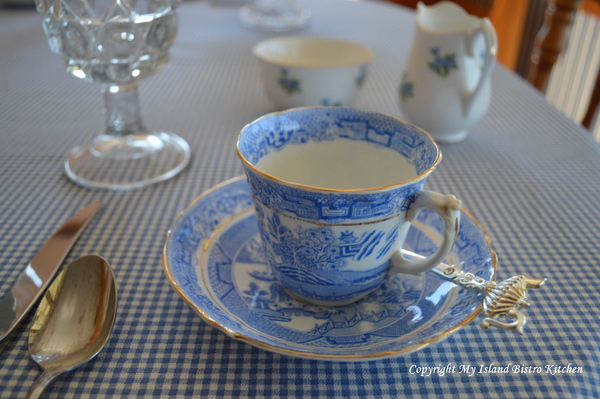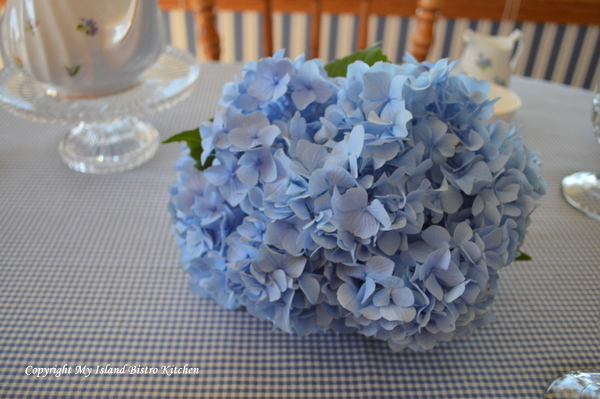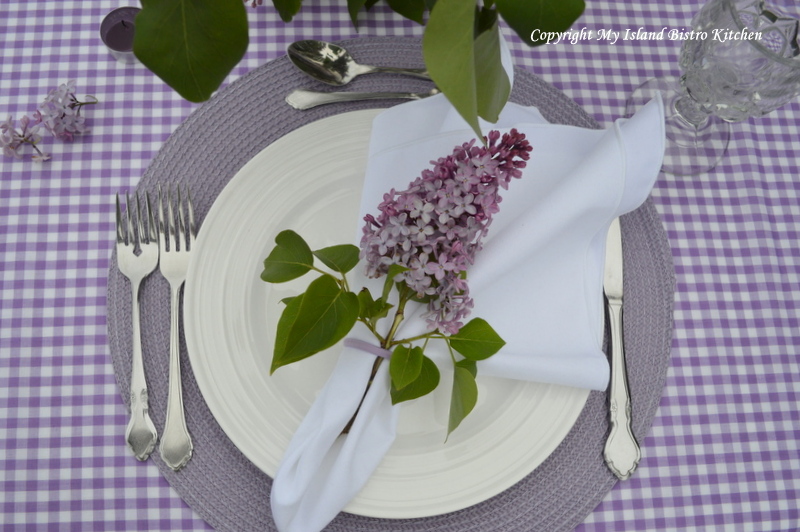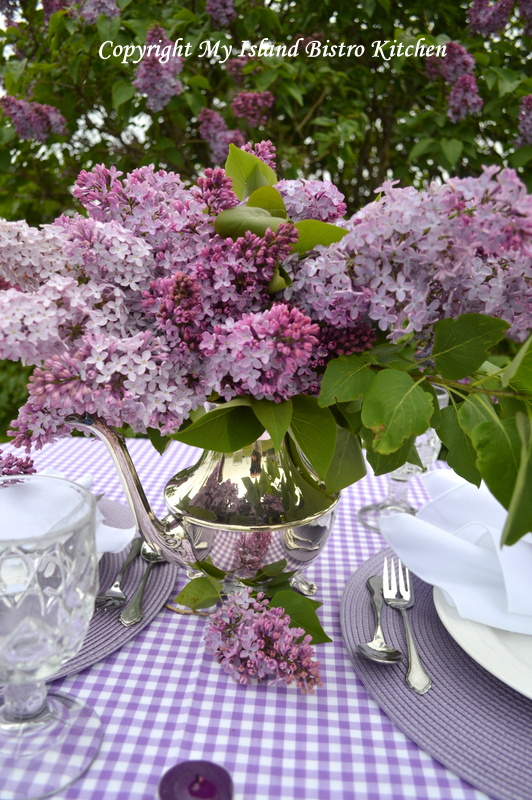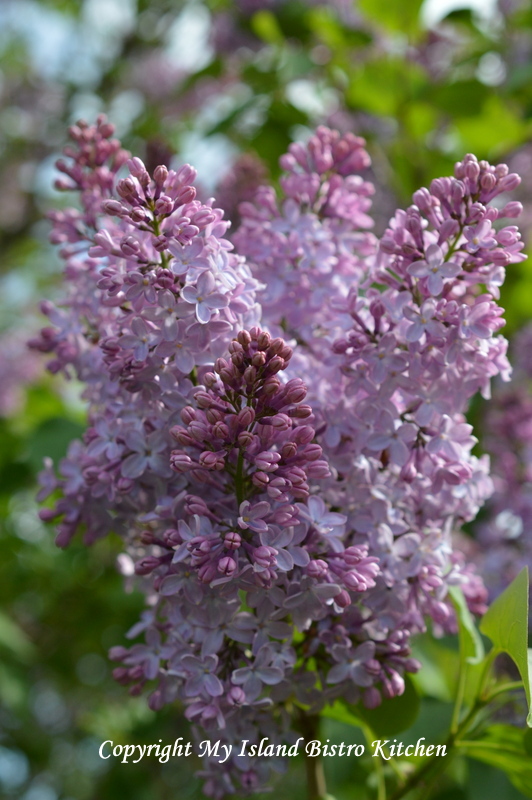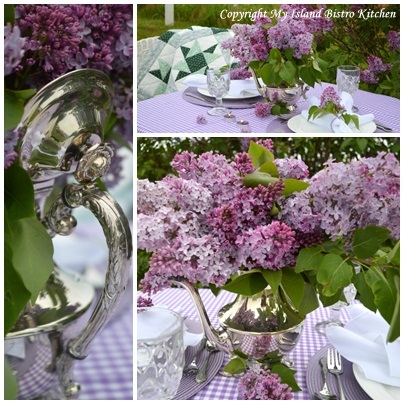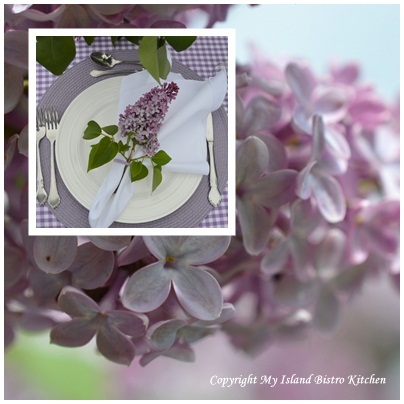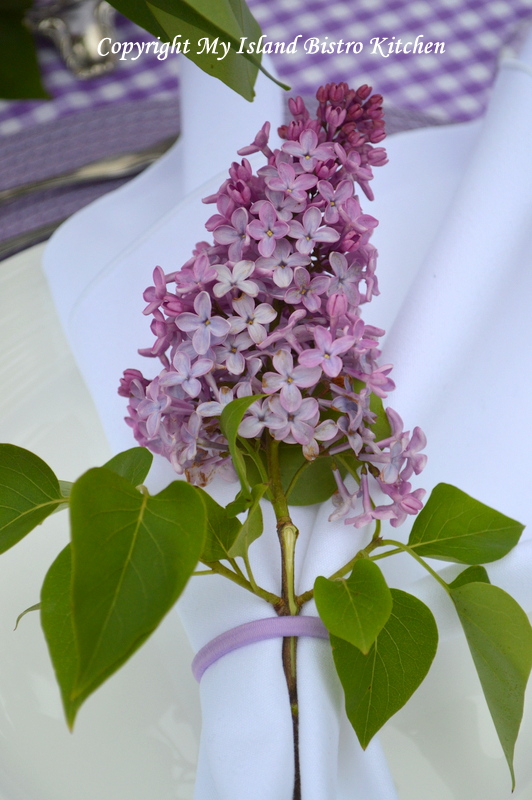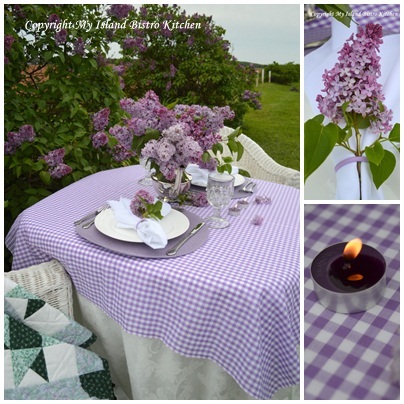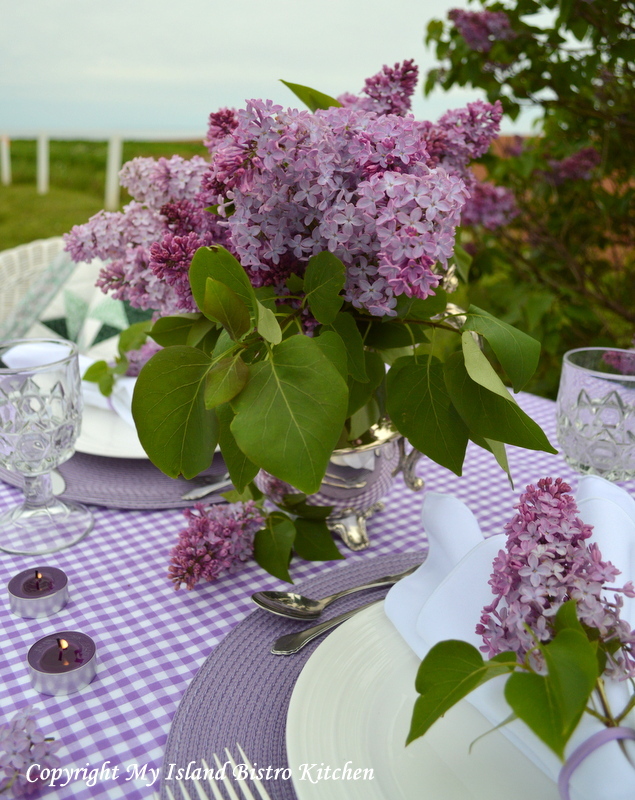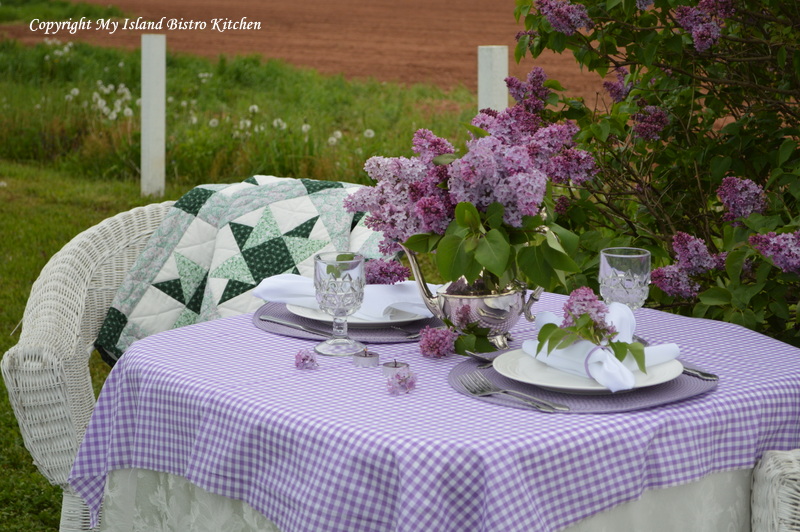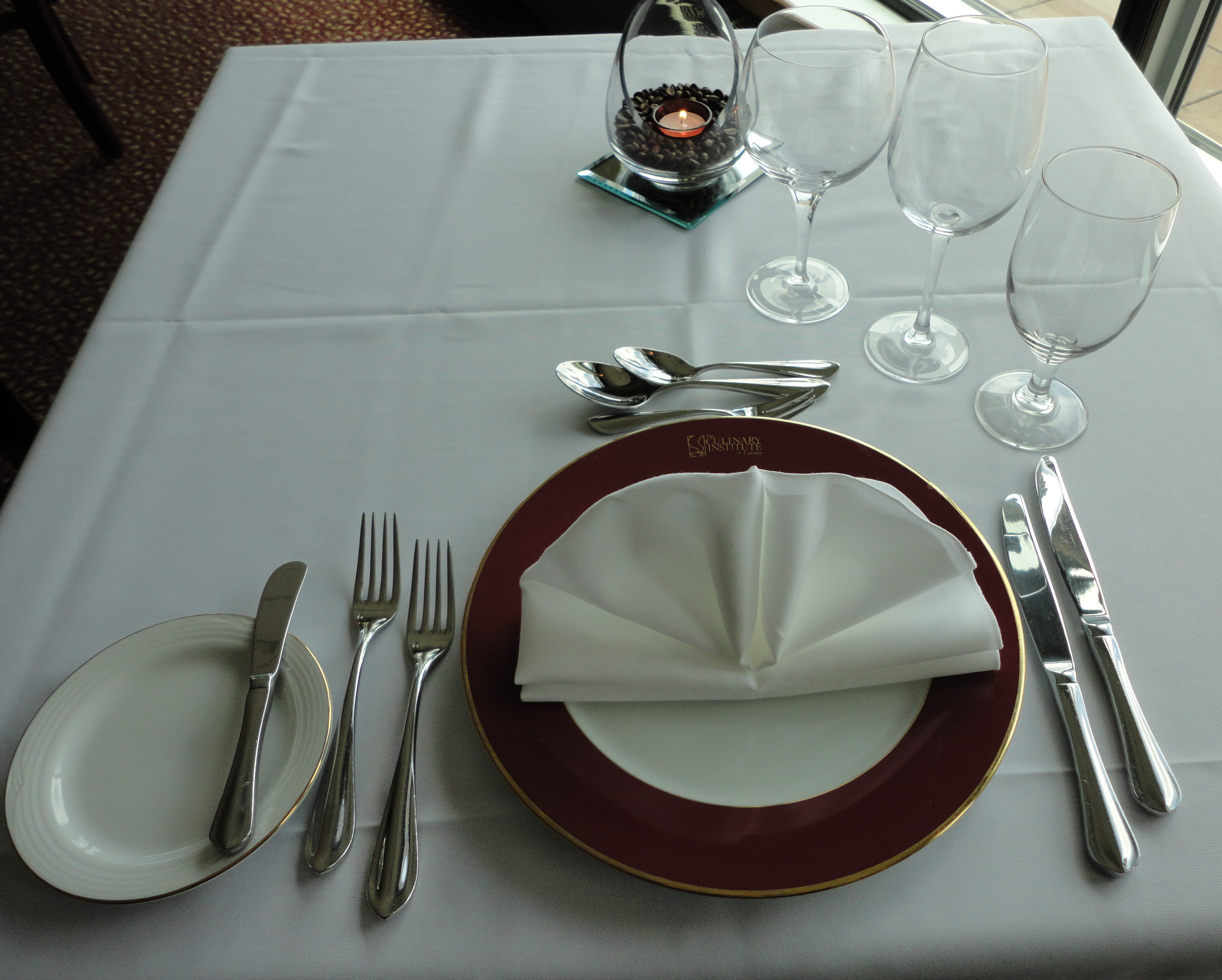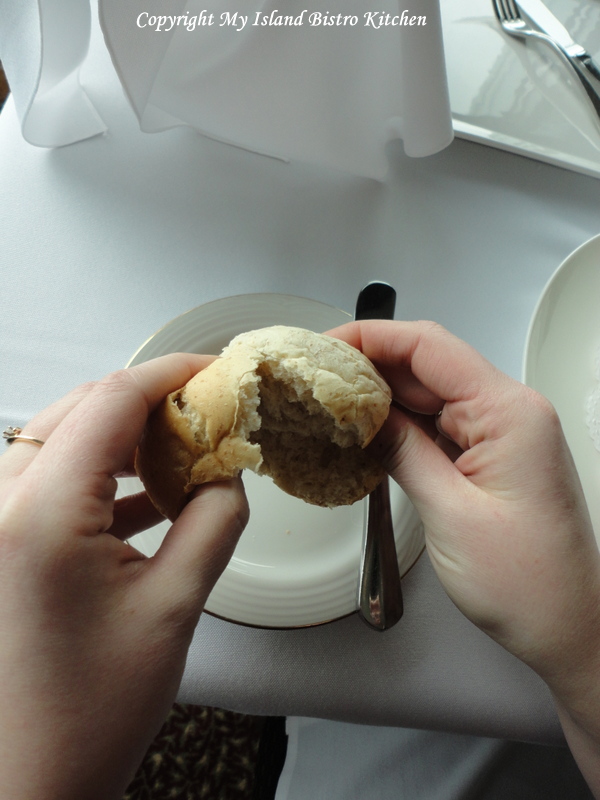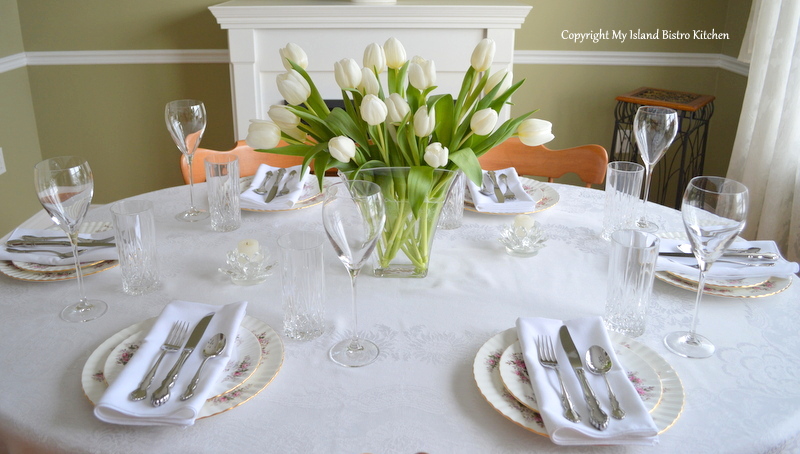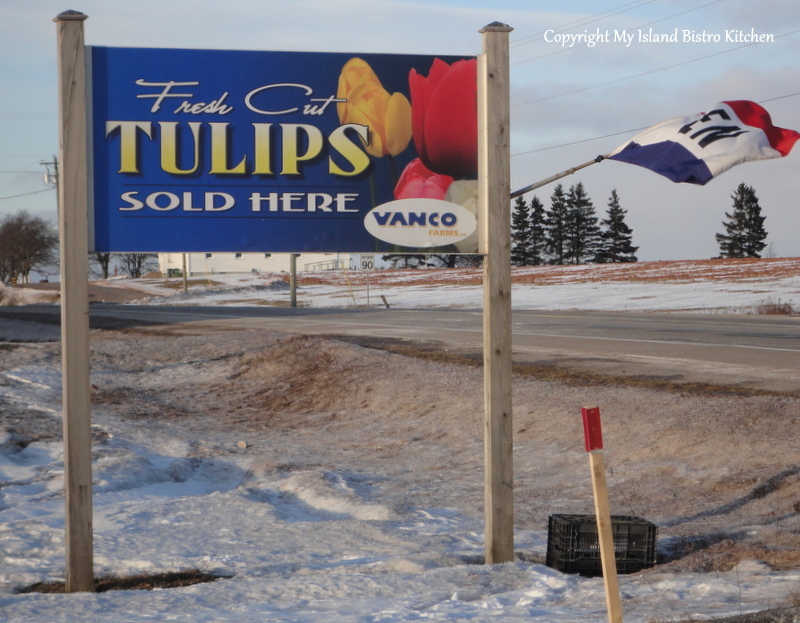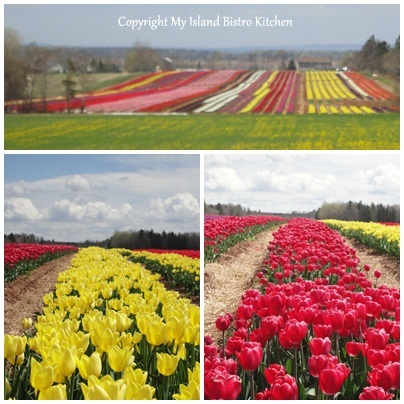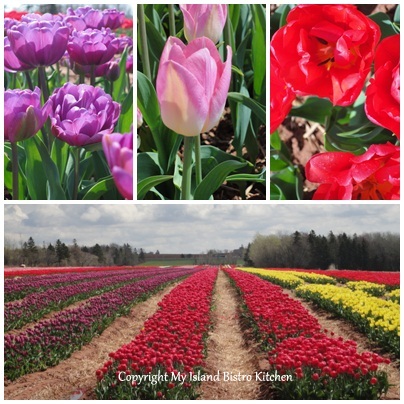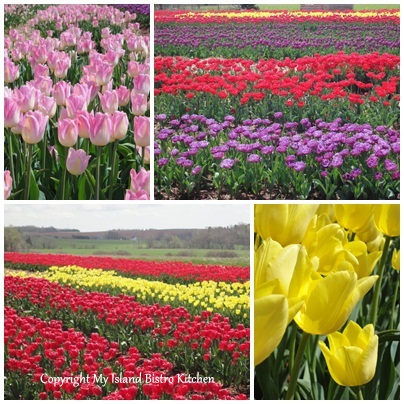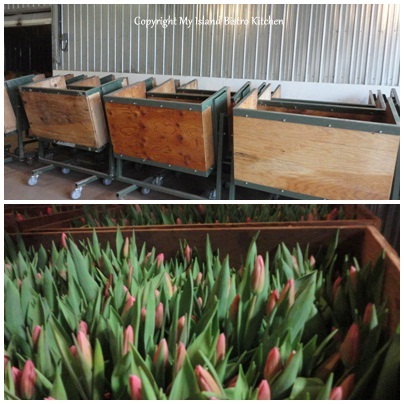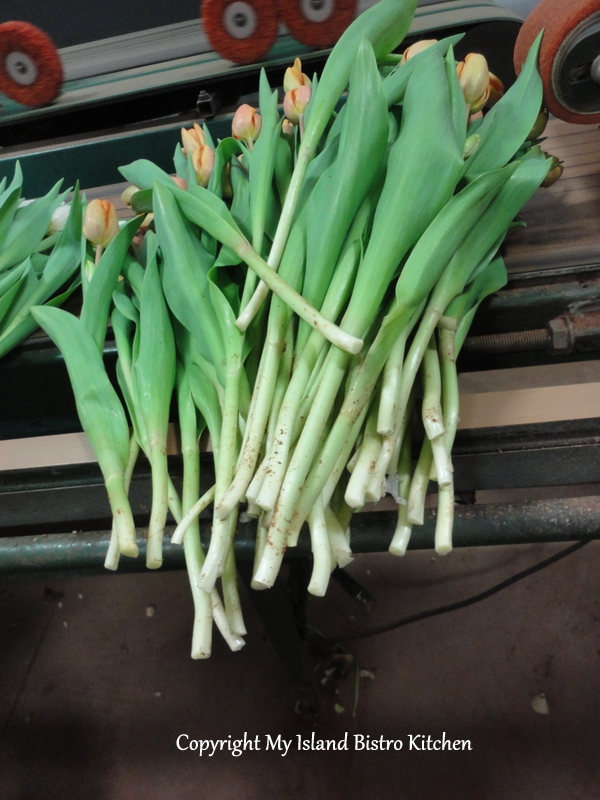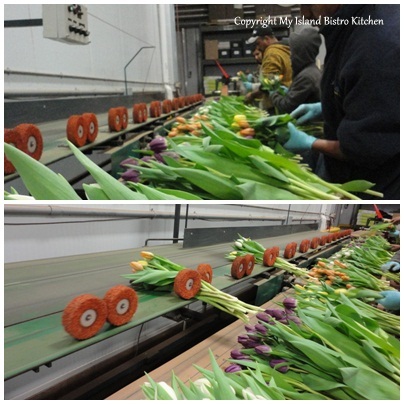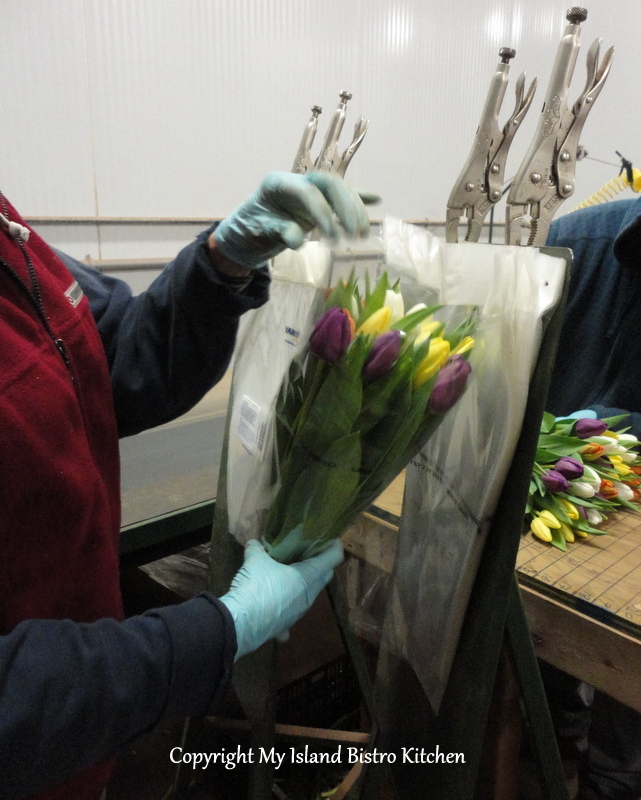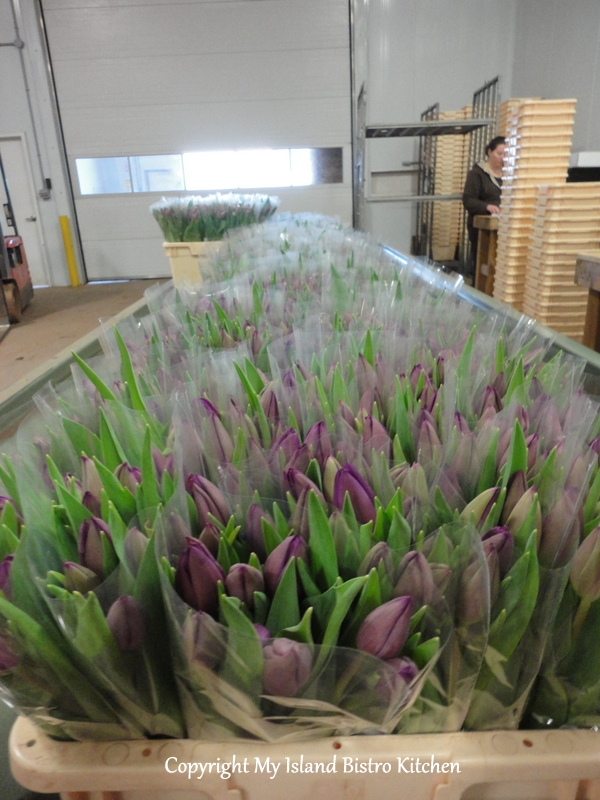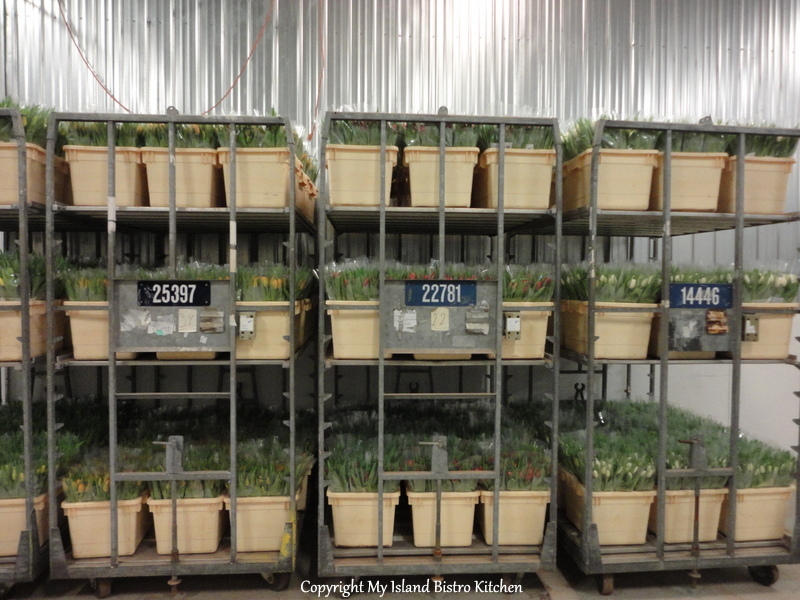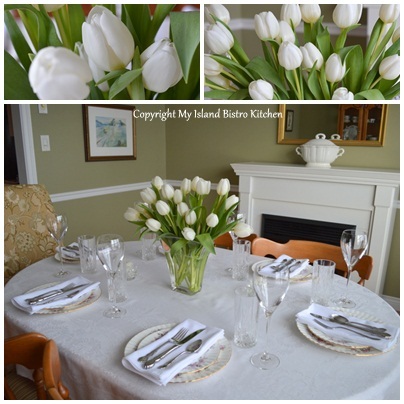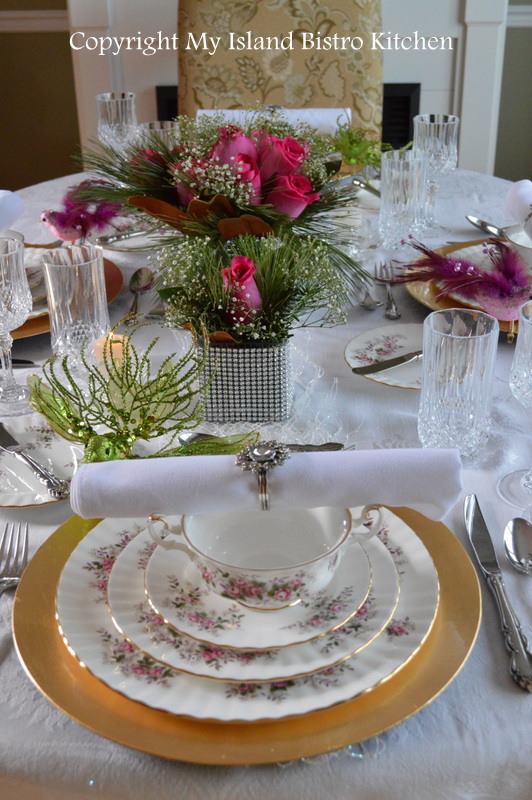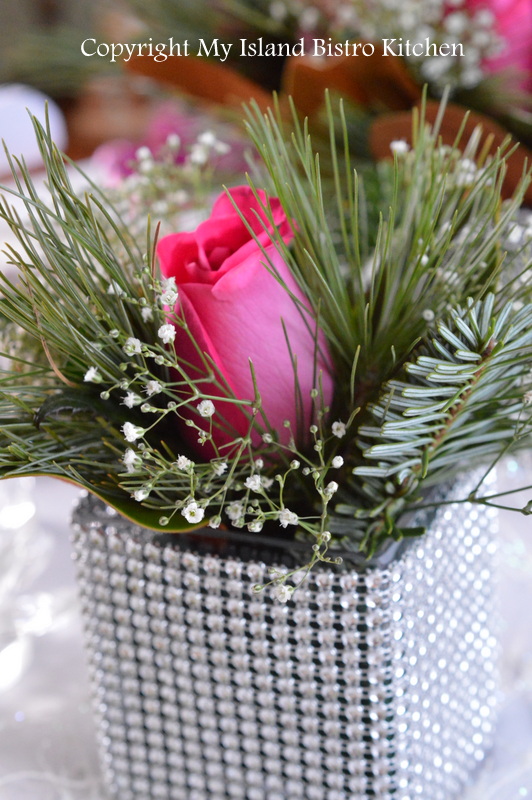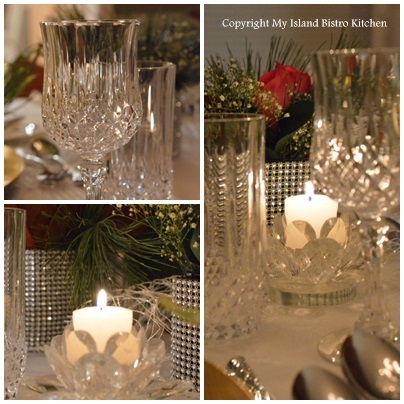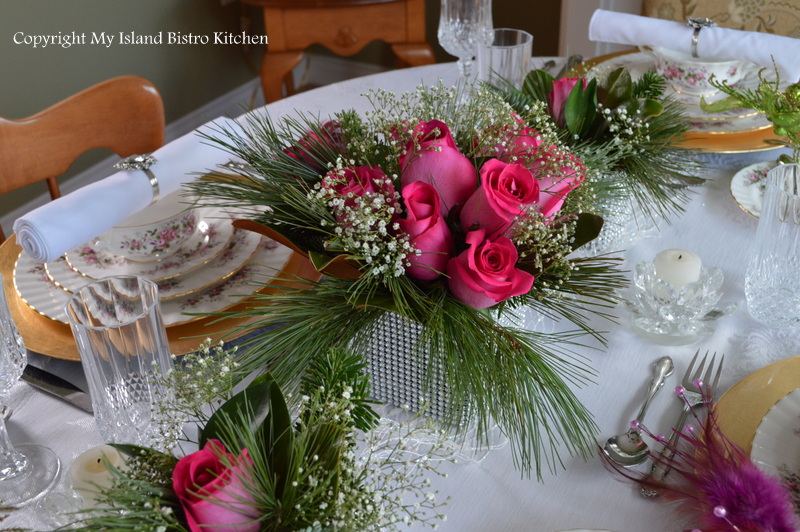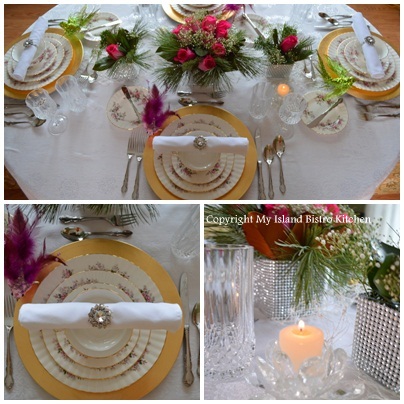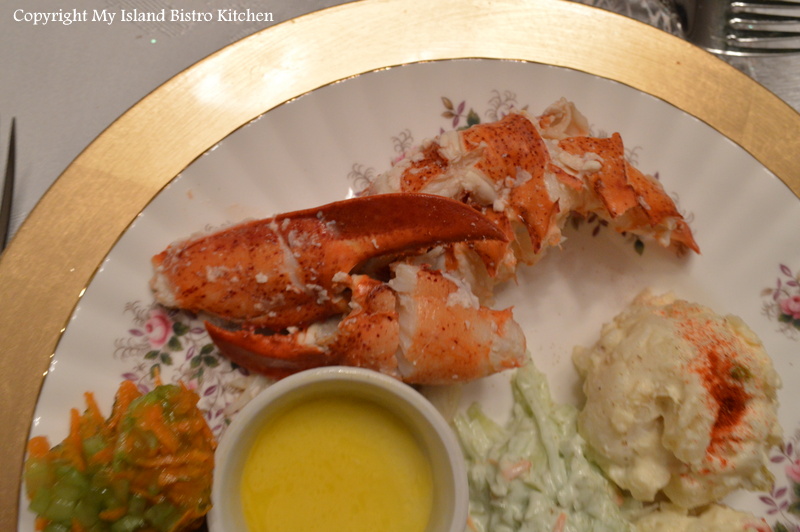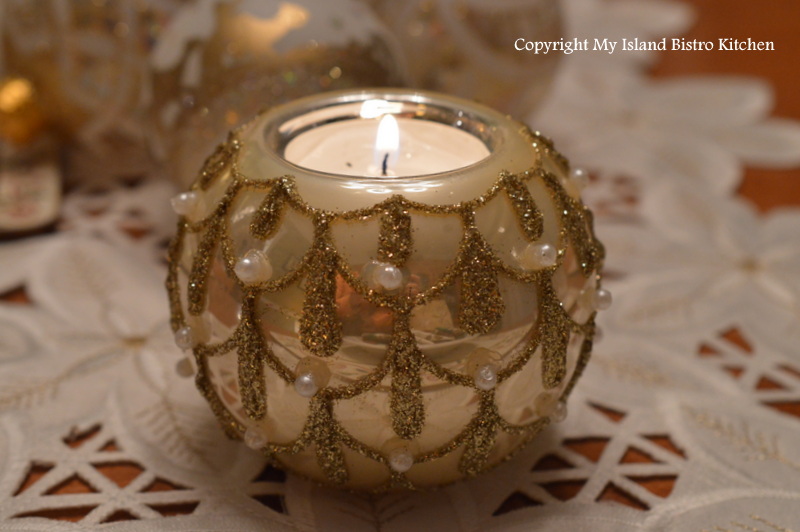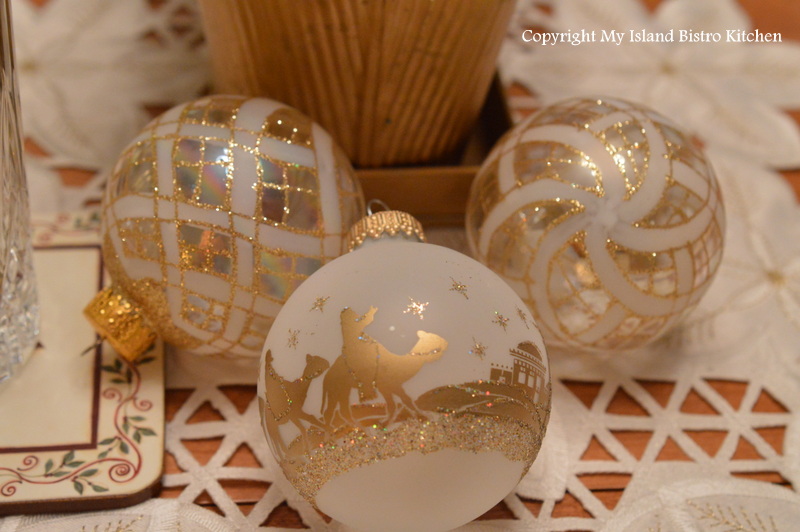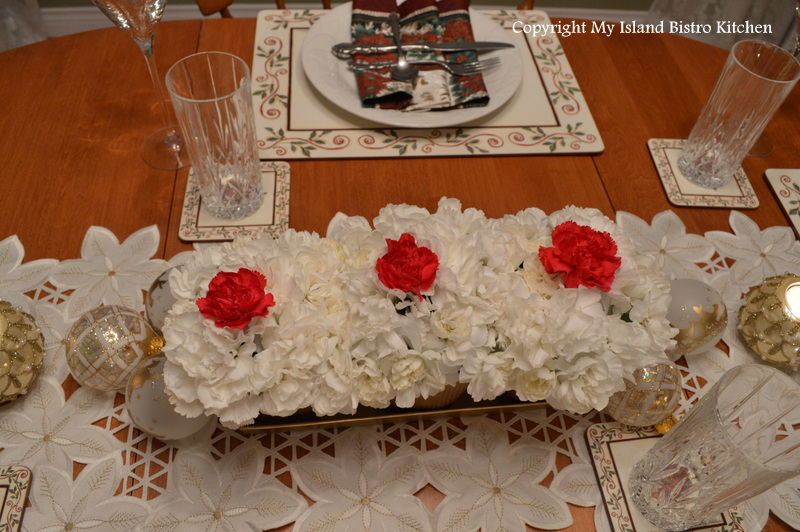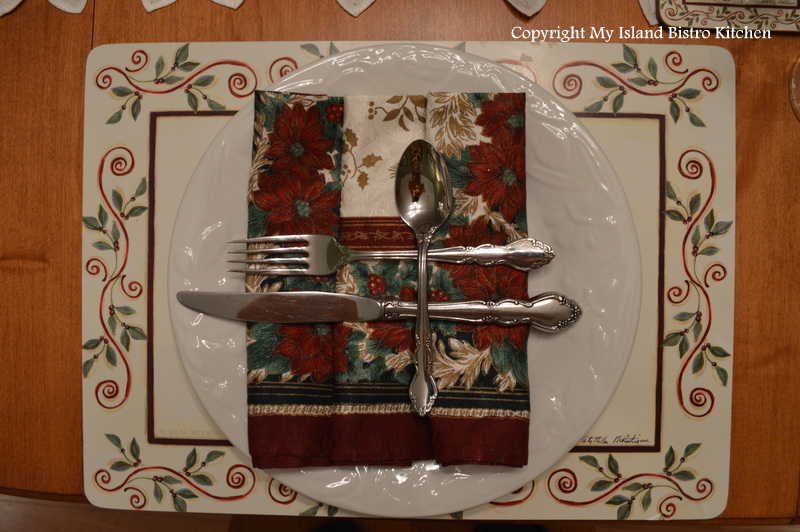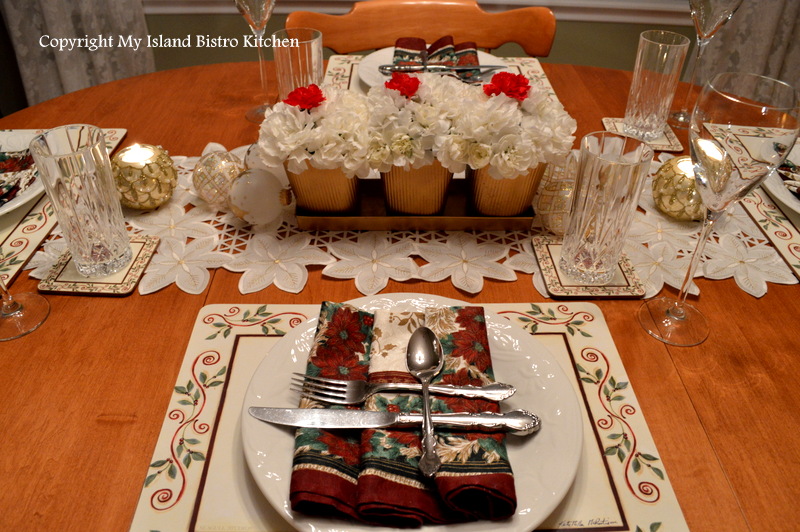Today, I am sharing photos from my Pink and Green Holiday Tablesetting. Continue reading The Pink and Green Holiday Tablesetting
Category Archives: Tablescapes
Christmas at My Island Bistro Kitchen
Well, Christmas has come and gone again for another year. I hope you had a joyous and peaceful holiday. I thought I would share with you the traditional components of my Christmas dinner. Guests were greeted with a glass of Sparkling Cranberry Apple Juice from Verger Belliveau Orchard in Memramcook, New Brunswick.
I like to set a pretty table. This year, I used a gold-colored tablecloth, a couple of gold-colored glass Christmas trees and some gold and ivory Christmas balls and used them to start building the tablescape. The gold theme seemed to blend in nicely with the tree and mantle in my dining room.
I kept the tablescape fairly simplistic and uncluttered since my dining room table is not large. It can seat six but four, more comfortably.
I like to add a bit of bling to the tablesetting. These blingy napkin rings were a find a couple of years ago. Napkin rings are very useful when you want to keep the napkin fold simplistic or when you are in a hurry and don’t have time to fold napkins into designs.
My choice of centerpiece was seasonally-inspired. The gold container and piks were in keeping with the gold theme and gold charger plates.
The Star of Bethlehem flower was the focal point of the centerpiece.
The holly berries came from one of my holly trees just outside my front door.
Since I couldn’t bring the snow indoors, bursts of Baby’s Breath gave the illusion of snow drops throughout the centerpiece.
Christmas Dinner was a four-course meal. The appetizer was a red pear drizzled with a pomegranate molasses dressing.
I love the burst of flavor in each of the pomegranate arils.
Not only do the arils add flavor but they also add texture and color to the plate.
Some Islanders have roasted parsnips as a traditional vegetable on their Christmas dinner plate. Parsnips were not a traditional vegetable for Christmas dinner in our home. However, I have included parsnips in the Parsnip and Apple Soup.
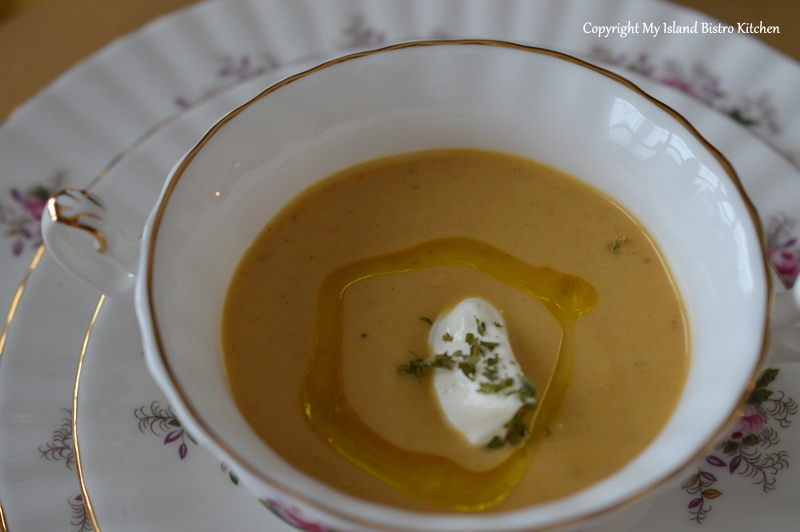
A dollop of sour cream surrounded by a drizzle of good quality olive oil dresses up this flavourful soup.
The soup’s golden color continues the gold-colored theme.
I love this little soup tureen I came across a couple of years ago.
Of course, the star of the show is the roasted turkey!
There is nothing like an old-fashioned roast turkey dinner! I dressed the turkey platter with a citrus theme of orange, lemon, and lime wedges along with green grapes and cranberries.
My choice of wine for this year’s Christmas dinner was Chardonnay that came from Matos Winery, St. Catherine’s, PEI.
We are very traditional in the components of the Christmas dinner – turkey, stuffing (dressing), mashed potatoes with homemade gravy (no gravy mix for me!), carrots, turnip casserole, and peas. Condiments included my homemade cranberry sauce along with mustard pickles and pickled beets that I made earlier in the fall.
Plum pudding is the traditional Christmas dinner dessert in our household.
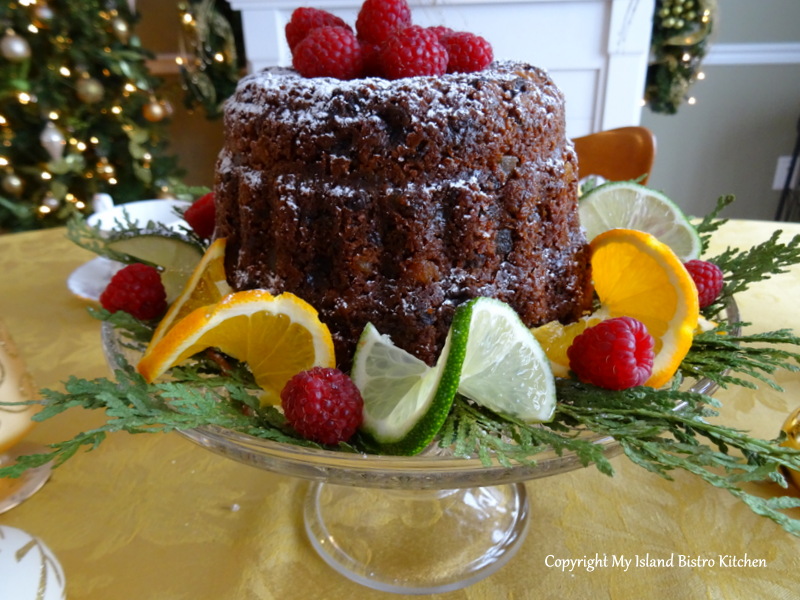
There are various toppings that are served with the steamed plum pudding; however, in our home, the brown sugar sauce (served hot) reigns supreme!
When presenting the plum pudding on a glass pedestal plate at the table, I kept the citrus theme going and added some fresh raspberries for color.
Plum pudding with a good cup of coffee – a fitting finale to a wonderful Christmas dinner!
I hope you have enjoyed a glimpse into our 2013 Christmas dinner. Best wishes to you and yours for a wonderful holiday season.
To view other Christmas and New Year’s Tablesettings, click on the links below:
Glitz ‘n Glamour New Year’s Eve Tablesetting
Twas the Night Before Christmas
The Warmth of the Christmas Light Tablesetting
A Tartan Holiday Tablesetting
Pretty Poinsettia Tablesetting
Poinsettia Trio Tablesetting
The Holiday Table
The Pink and Green Holiday Table
Christmas Eve Tablesetting and Dinner
Purple Tablesetting for the Holidays
Evergreens and Reindeer Christmas Tablesetting
Thank you for visiting “the Bistro” today.
Be sure to visit my Facebook page at My Island Bistro Kitchen. You may also wish to follow me on twitter @PEIBistro, on Pinterest at “Island Bistro Kitchen”, and on Instagram at “PEIBistro”.
Purple Tablesetting for the Holidays
Purple has been my favorite color for a long time so it’s not surprising that, many years ago, I chose a china pattern that had lavender in it. I came across wonderful purple-tinted small carnations at the local Superstore so purple became the theme of this tablesetting for a pre-Christmas holiday dinner party.
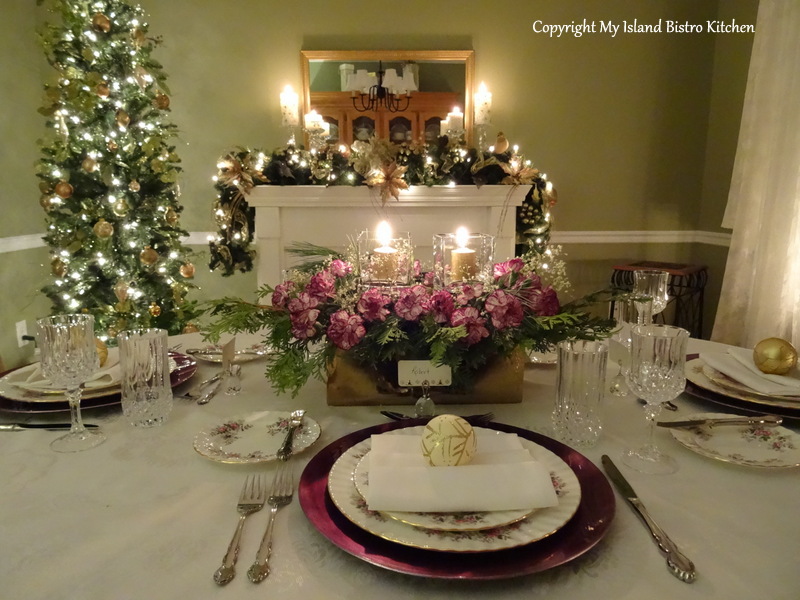
I have a number of different colored charger plates that match my china and I use them to change the look of the table. The purple chargers were an identical match for the carnations.
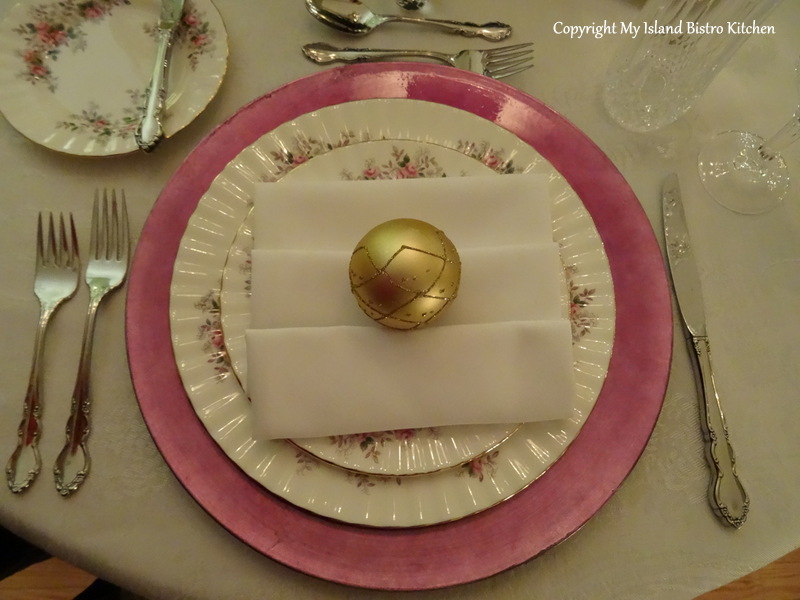
I really like working with white linen tablecloths as they give me a blank, undistracted canvas upon which to build the tablescape.
The napkin fold I chose was the simple “wave” fold. It is quick and easy to do. It’s very classic and unpretentious. I used gold-themed balls on each napkin to tie in with the gold rim of the plates and also with the container for the floral arrangement and the votives.
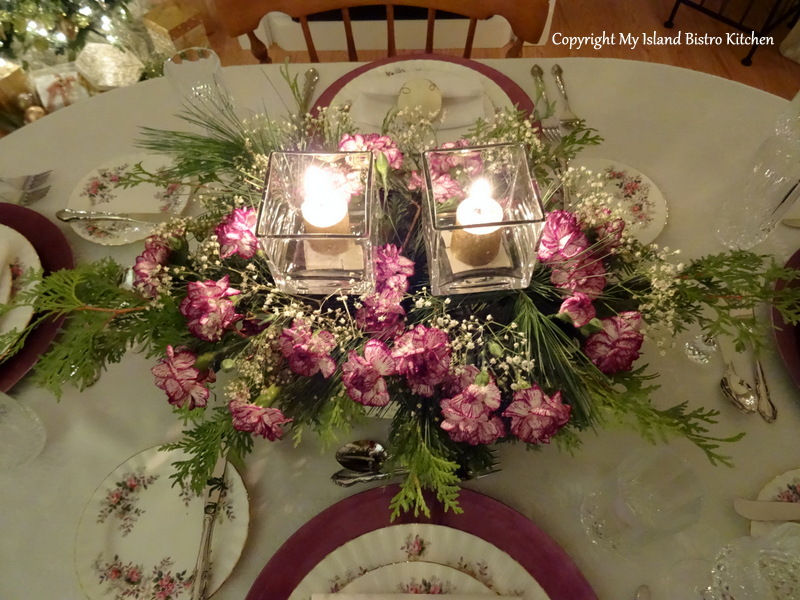
This was a very simple floral arrangement and easy to design. I buy huge bundles of different greens and keep them in a big bucket in my garage for use in preparing floral arrangements over the holidays. In this one, I used cedar and pine for the base then added the carnations and baby’s breath. In fact, the greenery will outlast the carnations so I will probably add new flowers and change the votives to another color over the holiday period to change up the look of my table.
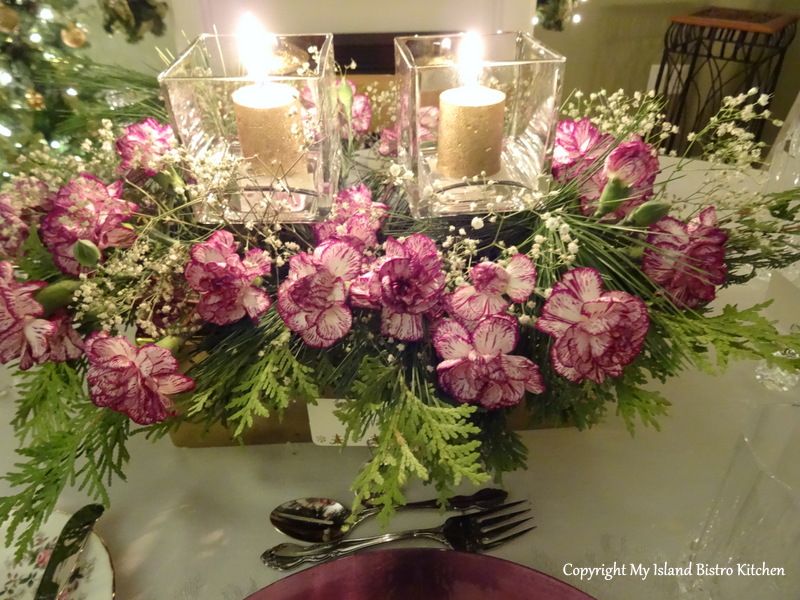
I like these votive holders – they have a three-pronged base that, when inserted into the floral oasis, become a very sturdy alternative to the precarious tapers. While I like the look of tapers, and do sometimes use them, they are not as carefree as votives as there is always a chance that someone will jerk the table and the candles might tip.
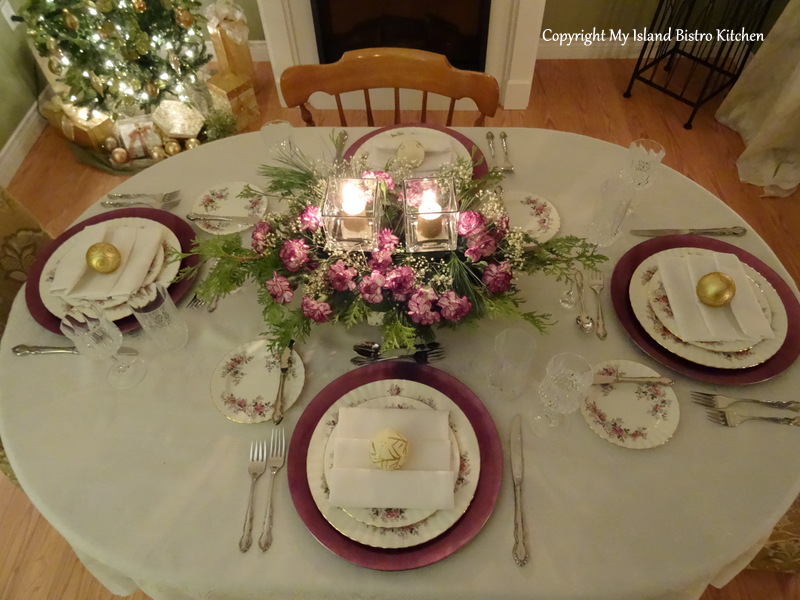
This is a very simplistic, uncluttered tablesetting, perfect for those dinner parties over the holidays.
Happy Holidays!
To view other Christmas and New Year’s Tablesettings, click on the links below:
Glitz ‘n Glamour New Year’s Eve Tablesetting
Twas the Night Before Christmas
The Warmth of the Christmas Light Tablesetting
A Tartan Holiday Tablesetting
Pretty Poinsettia Tablesetting
Poinsettia Trio Tablesetting
The Holiday Table
The Pink and Green Holiday Table
Christmas at My Island Bistro Kitchen
Christmas Eve Tablesetting and Dinner
Evergreens and Reindeer Christmas Tablesetting
Thank you for visiting “the Bistro” today.
Be sure to visit my Facebook page at My Island Bistro Kitchen. You may also wish to follow me on twitter @PEIBistro, on Pinterest at “Island Bistro Kitchen”, and on Instagram at “PEIBistro”.
Tea for Three Tablescape
On this beautiful warm, sunny Prince Edward Island day, I am sharing a simple tablescape for teatime with you. I have a three-piece setting of a very old blue tea set. It has no markings on it to tell me anything about what kind of china/porcelain it is or where it was made. If any of you recognize the pattern/manufacturer, please do let me know. It is very delicate and a cherished set to own.
I love both the daintily-designed teacups and their shape. I imagine some Victorian ladies enjoying their afternoon tea with this tea set.
My choice of teapot for today’s tea setting is one that has tiny flowers of several different colors. It is my go-to teapot for tea settings when I don’t have a teapot in the specific color of the dishes I am using. It is a versatile teapot because it is of no particular predominant color.
We have a wonderful blue hydrangea bush that blooms prolifically at the back door of the cottage so I thought two or three of the magnificent blue blooms would make a lovely centerpiece that would compliment the tea set.
The hydrangea are actually in a small square vase even though they look like they are just lying on the table!
I felt the tea set was elegant enough on its own that it really needed no further adornment on the table other than the blue hydrangea centerpiece.
I am belatedly joining Sandi’s Teatime Tuesday event at Rose Chintz Cottage this week.
Thank you for visiting “the Bistro” today. There are lots of ways to connect with “the Bistro” through social media:
Join My Island Bistro Kitchen on Facebook
Follow the Bistro’s tweets on twitter @PEIBistro
Find the Bistro on Pinterest at “Island Bistro Kitchen”
Follow along on Instagram at “peibistro”
Lovely Lilac Tablescape
I adore lilacs! I love their scent, color, and shape. I will admit they do have a very strong scent so I rarely bring them indoors. So, that causes me to use them in tablescapes for Al fresco dining. Lilacs are always something I look forward to in June.
We have a number of lilac trees and they make a wonderful backdrop for a June dinner. In the background, you’ll notice the red soil, characteristic of Prince Edward Island! This field has just been planted with potatoes.
Although it doesn’t show in the photo above, there is mauve in the quilt on the chair. Purple and all its shades, tints, and hues – yes, my favorite color! The quilt, entirely hand-quilted, was made by my mother.
I have an old silver coffeepot that has seen better days so I have re-purposed it and it now makes a ready vase for flowing flowers such as lilacs.
Lilacs do not require a lot of arranging since nature has pretty much arranged them beautifully in bunches on the tree already!
Some day in the winter, I will look at these photos and try and remember it really was warm enough to dine Al fresco in PEI!
The old coffeepot has such lovely detail on it that it was a shame not to find another purpose for it.
I have always liked checked tableclothes. This mauve one just seemed the perfect match for the lilacs.
When you like a color, it’s never hard to find matching accessories around the house, like the purple tealights and mauve placemats.
For the napkin, I loosely gathered the fabric, used a mauve hair elastic (yes a new one!), and inserted a lilac stem into the fold.
Lilacs don’t last long. They are here and gone before we know it.
These are just a standard lilac, no particular variety. Last year, I planted two French lilac trees and was surprised to see both bloom this year.
The bumblebees love the lilacs and are frequent visitors to our trees!
Thank you for visiting “the Bistro” today. There are lots of ways to connect with “the Bistro” through social media:
Join My Island Bistro Kitchen on Facebook
Follow the Bistro’s tweets on twitter @PEIBistro
Find the Bistro on Pinterest at “Island Bistro Kitchen”
Follow along on Instagram at “peibistro”
Dining and Guest Etiquette
It’s the beginning of the season of wedding receptions, summer dinner events, get-togethers, and banquets. I thought this might be a good time to post an article on dining and guest etiquette. Many of us, at one time or another, have probably found ourselves at a dinner event, sat down to a somewhat crowded table with heavily laden place settings that displayed more cutlery and glassware than imaginable and wondered, hmmm, which bread plate was ours – the one on the left or on the right of the place setting. Or, perhaps you have wondered what to do if your neighbour to the left has started to use your bread and butter plate thinking it was his or hers. Maybe you have deliberated over which utensil to use. Perhaps you have wondered if it is proper to tilt or pick up a soup bowl to get the last drop of that yummy soup. For answers to these and other guest and dining etiquette questions, I contacted Tina Lesyk, Banquet and Catering Coordinator at The Culinary Institute of Canada in Charlottetown, PEI. I first introduced you to Tina in May 2012 when I posted a feature on how to properly set a table.
The purpose of learning and practicing proper table manners is to feel comfortable at any table, not insult your host or hostess and, in the case of business functions, it is essential for professional success. Let’s face it, no one wants to embarrass him or herself in these social situations. Follow the basic guidelines outlined below and you’ll be well on your way to being a model dinner guest in any setting, whether that be at a dinner in a private home, in a restaurant, or at a formal or state dinner. For a description and explanation of the elements of place settings, please see my earlier posting “Let’s Set the Table”.
First, let’s begin with some general tips on dining and guest etiquette.
General Dining Etiquette
– The old rule still holds true – elbows off the table when food is present.
– You should sit in the chair so that your back does not actually touch the back of the chair – this forces you to sit up straight.
– Everyone, leave the tech gadgets away from the table. Out of respect for the host/hostess and other guests, put cell phones on vibrate. If you absolutely must take a call during dinner, never answer the phone at the table in the presence of the host/hostess and other guests. Excuse yourself and move to another room to discretely take the call. The same applies to making a telephone call.
– Never use a toothpick while at the table. Picking food out of your teeth in front of fellow guests and the host or hostess is not appropriate conduct.
– If you drop a piece of cutlery on the floor, leave it there; do not retrieve it. If you are in a restaurant, signal to the waiter to bring you a replacement. If at a private event at someone’s house, ask your host/hostess for a replacement.
– If you find you have taken a bite of food that has a piece of gristle or small bone in it, do not make a big scene or draw attention about it. As discretely as possible, remove the item with your fork (the utensil it went into the mouth with) and set it to the side of your plate.
– If you have a severe food allergy, advise your host/hostess in advance of the function.
– If you are served a food that you do not like and cannot eat, make no mention of it; rather, simply go through the motions of moving the food around the plate.
– Never push the plate away from you when you have finished eating and do not stack up plates, utensils, and so forth, from your place setting – you may think you are helping but this gets in the way of the servers’ techniques for clearing tables.
– Applying lipstick, combing hair, and so forth are considered grooming activities, inappropriate for the dining table.
Napkins
The purpose of the napkin is to protect clothing by acting as a shield or guard for spills and, if necessary, to dab the fingers and mouth, and remove traces of food particles from the outside of the mouth.
– Remove the napkin from the place setting and place it on your lap immediately upon being seated at the table.
– For a normal-sized napkin, completely unfold the napkin and place it on your lap. It is not considered appropriate (and there is no need) to “shake” a napkin out of its fold. Simply, and very discretely, unfold the napkin.
– If the napkin is exceptionally large, fold it in half and, with the fold of the napkin facing you, place it on your lap.
– The napkin always goes on the lap and is never tucked into the collar and used as a bib.
– The napkin remains on your lap during the entire meal. If you need to temporarily leave the table during the meal, loosely bunch up the napkin and place it to the left of your plate. When you return to the table, re-place the napkin on your lap. At one time, the general rule was to place the napkin on the seat of your chair during a temporary absence from the table. However, there are a couple of issues with this that suggest an alternative location for the napkin may be preferable. First, the napkin may have food particles on it that will stain an upholstered chair and may also stain your clothing or leave crumbs on the chair when you return to the seat. Second, given the sole use of a napkin is to dab the mouth, many do not want to use that napkin for that purpose after it has laid on the seat of a chair that is used for, uh, sitting on the derrière. One never knows how clean those chairs are! Now, when bunching up the napkin that has stains or food particles on it, you will want to loosely fold the napkin in such a way that the stains/food particles are not visible when you temporarily leave the napkin on the table during your absence; leave the napkin, clean side up. You will also want to make sure your napkin does not touch the elements of the place settings of your neighbors to the left and to the right.
– A napkin is not a tissue or handkerchief so avoid using it to blow your nose (Note – you should excuse yourself from the table before blowing your nose).
– At the end of the meal, loosely bunch up the napkin and place it to the left side of your place setting, not on the dirty plate. A paper napkin, however, could be left on the [dirty] plate since the napkin will be discarded anyway.
Cutlery
– If the cutlery is already on the table, begin using the utensils placed farthest away from the plate (assuming there is more than one fork and knife at the place setting). If there is no cutlery at the place setting when you sit down at the table, this means the host/hostess will bring the necessary utensils with each course of the meal.
– Never gesture or point with a piece of cutlery.
Proper Ways to Hold Cutlery While Eating
There are two main styles – American and European.
American
Normally, with this style, you hold the fork in the hand you write with. For demonstration purposes, I will describe the procedure for someone who is right-handed.
Hold the fork in your left hand and the knife in the right.
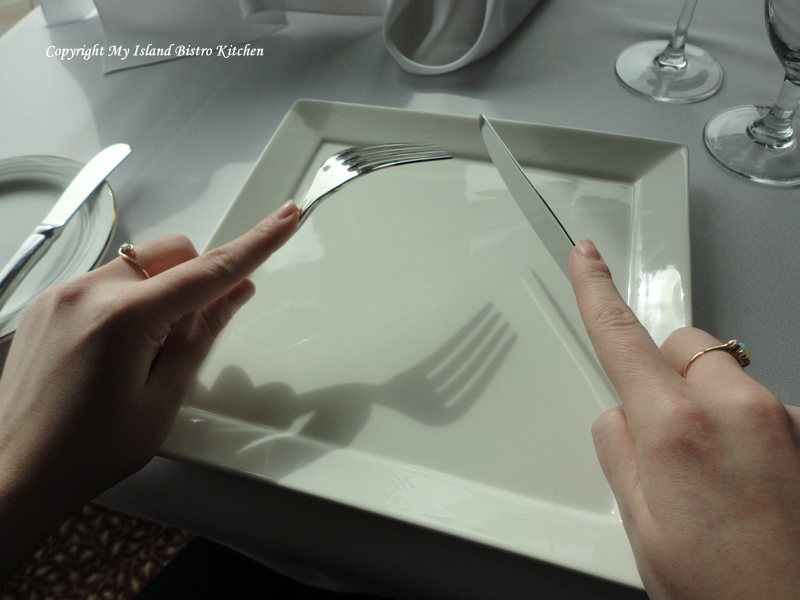
With fork tines facing down, gently spear the food with the fork to hold it in place as you cut the food. Once a bite-sized piece has been cut, rest the knife diagonally across the upper right edge of the plate. Switch the fork to your right hand and, with tines facing up, pick up the food and transfer it to the mouth.
If there is a pause in eating a course during the meal (e.g., to take a sip of water or briefly leave the table), there is a way to signal to the wait staff that you have not yet finished eating. Lay the fork, tines facing up, as shown in the photo below and place the knife, diagonally on the upper right-hand corner of the plate. Note that, once the knife has been picked up from the table, it should not touch the table again during the meal.
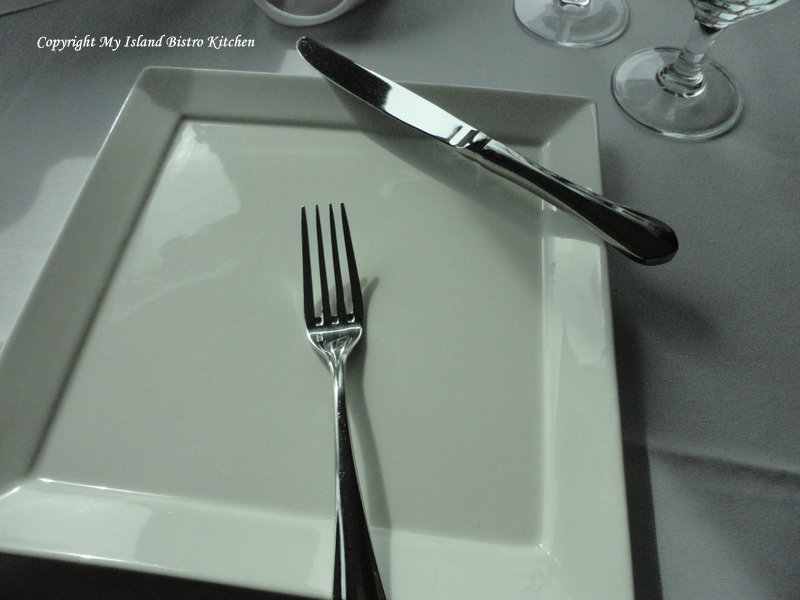
At the conclusion of the course, place the knife and fork together (fork tines up), parallel to each other at about the 4:30 clock position on the plate to signal to the wait staff that you have finished eating.

European
With this style, the fork remains in the left hand and the knife in the right for the entire meal. Food that needs to be cut is speared gently with the fork and cut with the knife held in the right hand. The knife is used to push food onto the back of the fork. The food is then transferred to the mouth with the fork, tines facing down, held in the left hand.
If there is a significant pause during the course, the fork and knife are placed on the plate as shown in the photo below.

At the conclusion of the course, place the knife and fork together (fork tines facing down) at about the 4:30 clock position on the plate to signal to the wait staff that you have finished eating. This would be the same as the American style with the only difference being that the fork tines would face downward toward the plate.
Which is mine?
– Follow this easy trick for remembering which bread and butter plate and which glass is yours: With your left hand, touch the tip of your first finger to your thumb. You will see it makes a lowercase “b” shape; “b” stands for “bread” – it goes on the left of the place setting, aligning with your left hand. Now, do the same thing with the first finger and thumb of your right hand. This makes a lowercase “d” shape. The “d” stands for “drink” and drinks go the right of the place setting, aligning with your right hand.
– If you find your neighbour has already starting using your bread and butter plate, discretely ask your host/hostess (if at a private dinner party) or your server at an event to bring you another.
Bread and Rolls
– Break bread and rolls with your fingers (as opposed to cutting with a knife). The knife is provided for buttering the bread or roll, not cutting it.
– If the bread or roll is served cold, take the butter pod and place it on to the bread and butter plate provided and butter each piece/bite of the broken bread or roll at a time as you eat each bite.
– If the bread or roll arrives warm at the table, break it apart and butter each broken section all at once to let the butter melt.
Soup
– The appropriate way to consume soup is to scoop it away from you as you will be less likely to spill or splash it on yourself.
– Do not place the entire bowl of the soup spoon in the mouth. Rather, sip the soup from the spoon.
– It goes without saying that there should be no ‘slurping’ noise during the soup-eating process!
– If the soup is too hot to comfortably consume, wait for it to cool. It is never considered proper etiquette to blow on the soup or stir it vigorously to cool it.
– It is inappropriate to dip bread in the soup as a way to gather up the soup – this is what a soup spoon is for.
– It is acceptable to tip the bowl ever so slightly away from you to scoop up the last bit of soup.
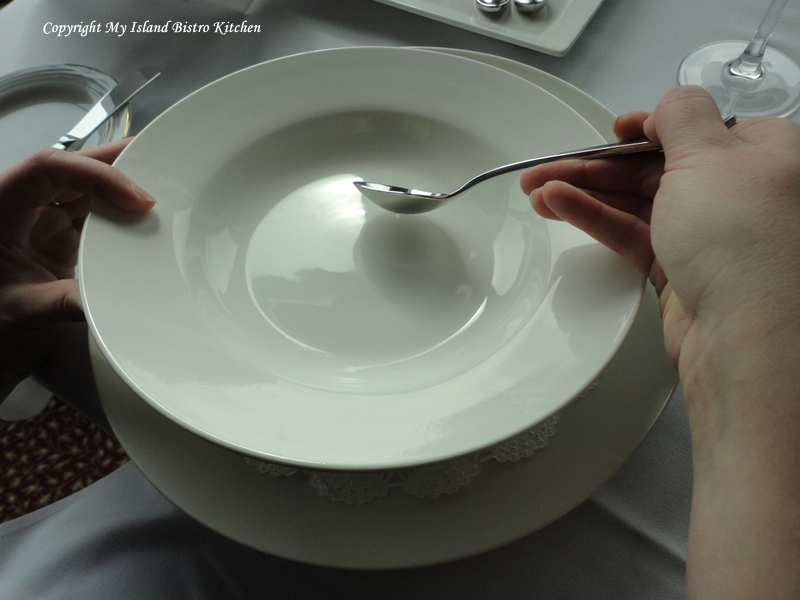
– It is not appropriate to lift the bowl up and hold it close to the mouth as you consume the soup.
– If the soup bowl has been served on a server plate, place the spoon on the server plate once you have finished the soup. If there is no server plate provided, leave the spoon in the bowl.
Wine
– If you are not a wine drinker, or do not want any wine with the meal, there are two ways to handle the situation when wine is being served: 1) discretely place your hand on top of the wine glass as the server approaches you with the wine. This will signal to the server that you do not wish to partake; or 2) simply let the server pour the wine and just do not drink it. The key is always discretion – you don’t want to make an issue of anything or draw attention to yourself.
– The proper way to hold a wine glass is by the stem so that your hand does not warm the wine or that fingerprints get left on the goblet itself, making it look smudgy. Holding the glass by the stem is also considered to give you better control when moving the wine in the glass and tasting it.
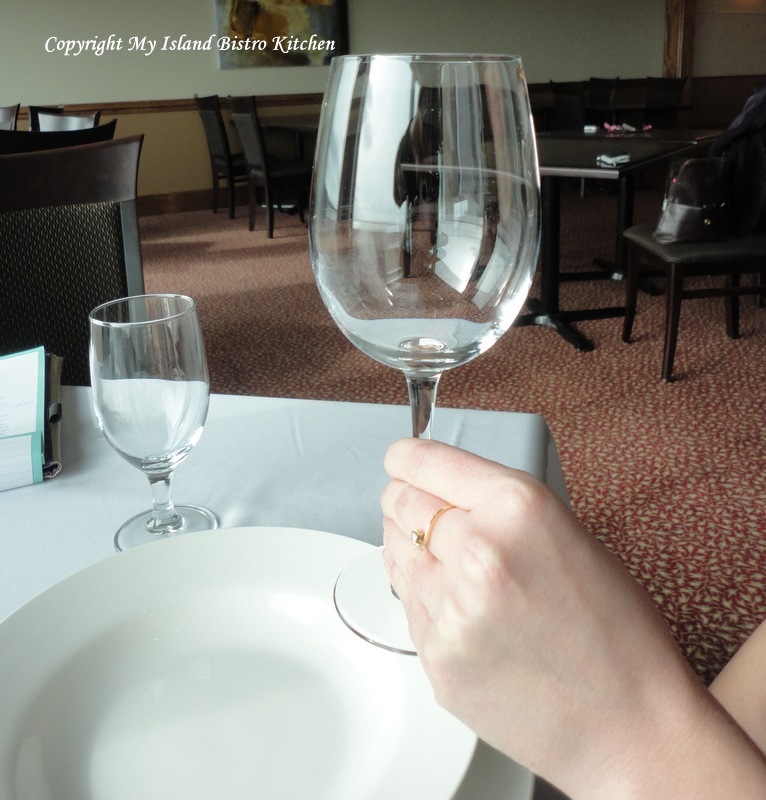
– Monitor your consumption – if several wines are being served throughout the meal, it is completely acceptable etiquette not to finish every glass. Intoxication does not make a good dinner guest.
Starting to Eat
– Wait for everyone at the table to be served before starting to eat. This applies to each course of the meal. If you are at a private dinner, it is proper etiquette to wait until the host/hostess picks up his or her fork before starting to eat unless, of course, the host/hostess tells you to start while he or she is still continuing with the dinner preparations and serving other guests.
– If food bowls, platters, etc., are being passed around the table for guests to serve themselves and one is starting with you (i.e., you pick up the bowl or platter directly in front of your place setting), offer it first to the person on your left while holding it for him/her to serve him/herself. Then serve yourself and pass the item to the person on your right. Always send everything to the right around the table and never directly pass items to guests across the table.
– Never intercept food being passed. For example, if someone asks for the basket of rolls to be passed, do not sneak a roll from the basket as it is going by you. Rather, after the requester has been served, ask for the item to be passed back to you.
Salt and Pepper Shakers
– Salt and pepper shakers should always travel in a set together even if someone ask for just the salt or pepper to be passed to him or her. This is because the next person looking for them will find them together, not orphaned here and there somewhere on the table and end up having two people passing them from different directions along to the requester. When someone ask you to pass him or her the salt and pepper, set them down on the table in front of the requester. This is the preferred method as there is less chance of dropping the items or upsetting them as could happen if they were transferred hand to hand.
– It is considered proper etiquette to always taste the food before seasoning it or you may insult the chef/host/hostess who has prepared the food – theory being that the chef has already properly seasoned the dish before serving it.
Special Food Items
Ever wonder what foods must be eaten with a fork and knife and which ones are acceptable to be eaten with the fingers? Here are some of the more common foods which are acceptable to be eaten with the fingers:
Asparagus (unless covered in a sauce)
Crispy bacon (ever chase a piece of crispy bacon with a fork around the plate as you try to capture it or cut it with a knife and the bacon lands on your neighbour’s plate?)
Oysters (probably the only, or one of very few, foods that can be acceptably eaten with a ‘slurping’ sound!)
Corn on the Cob
Pizza
Crostini
Artichokes
Chicken Wings
Ribs
Shrimp
Cookie served with a dessert (the cookie is considered a finger food)
Dinner Conversation
– Stay with topics that are neutral and of general interest, non-conflictual in nature – the old advice about avoiding discussions on politics and religion still holds true. The last thing you want to do is to instigate, or become engaged in, a heated discussion that leaves everyone around the table uncomfortable or at odds with each other.
– Do not discuss food allergies, health issues, or bad experiences with food. The fact that you may be lactose intolerant, have irritable bowel syndrome, or once got violently sick from eating shellfish, or have had food poisoning, does not make these subjects suitable table topics. As they say, that’s way too much information and detail, particularly at a dinner table where food is being served. Nothing can zap an appetite faster than to have a dinner guest regaling at length the graphic details of a bad food experience.
My thanks again to Tina Lesyk for taking the time to chat with me about proper guest etiquette and to share her extensive knowledge on the topic. We certainly haven’t covered every aspect of dining etiquette but, hopefully, we have covered the main points. Happy dining!
Thank you for visiting “the Bistro” today. There are lots of ways to connect with “the Bistro” through social media:
Join My Island Bistro Kitchen on Facebook
Follow the Bistro’s tweets on twitter @PEIBistro
Find the Bistro on Pinterest at “Island Bistro Kitchen”
Follow along on Instagram at “peibistro”
Tulip Tablescape and a Visit to Vanco Tulip Farm
Update 2019: While Vanco Farms still grow wonderful tulips in their Mount Albion greenhouses for sale and export, they no longer (as of January 2019) operate a retail outlet open to the public on the premises. Their fabulous tulips are, however, available locally at several retail outlets around PEI, including major supermarkets and florist shops.
It’s time again for me to share another tablesetting with you. This time I was preparing for a casual dinner party for six and I was featuring Island-grown tulips in my centerpiece. I wanted to keep the tablesetting very simple and streamlined, unpretentious, and understated. But first, let’s go on a field trip to Vanco Farms to get the tulips and find out about their tulip-growing operation.
Last week was the coldest week yet on Prince Edward Island this year. On Tuesday mid-afternoon, when I headed east out of Charlottetown, across the Hillsborough Bridge, I glanced at the computer screen on my dashboard and it was reading an outside temperature of a balmy -14C (without windchill factor which some days was down around the -30C to -34C range). As I drove along, I thought this was an interesting day to be heading to a tulip garden, a huge one at that.
I have often stopped by Vanco Farms in Mount Albion, about a 15-minute drive outside of Charlottetown, to pick up some of their fabulous tulips at their onsite retail outlet. While sometimes I do purchase the tulips at a local supermarket, there is something about buying product right at source – the freshness is unbeatable. Last winter, I was rarely without their tulips throughout the house and, particularly, on my dining table. I had contacted Vanco Farms last spring about doing this story in connection with a tablescape but it was near the end of their season and they suggested I wait till January when their greenhouse operation would be in full swing.
As is the case with several stories, particularly ones where growing food or flowers are involved, the story evolves over several months so I can capture the various steps in the process. So, let’s pick up the story way back on May 10, 2012, when, in preparation for this feature, I photographed a huge field of Vanco tulips in full bloom in Pownal, PEI.

This was a field of tulips that were about to be cut down so that all the plants’ energy would be generated towards their bulbs that grow and multiply underground and not directed into the pretty blooms. How heartwrenching to see a tractor and cutter mowing down all these colourful petals; however, it is for long-term gain. The bulbs that are large enough will go for bulb sales or will make their way into the greenhouse to be grown for cut flowers over the winter. The smaller bulbs will be replanted in the fall and will be given the time to mature and grow into the more desirable large bulbs. Large bulbs will produce the larger, more premium blooms with stronger stems.
Aren’t these fabulous colors!
So, fast-forward to January 22, 2013, when I visited the Vanco greenhouses and production facility. I was met by Bas Arendse who toured me through their tulip-growing operation. Seriously, on a cold January day, there is nothing more uplifting than to stroll through warm, bright greenhouses with thousands of tulips at various growth stages through to bloom.
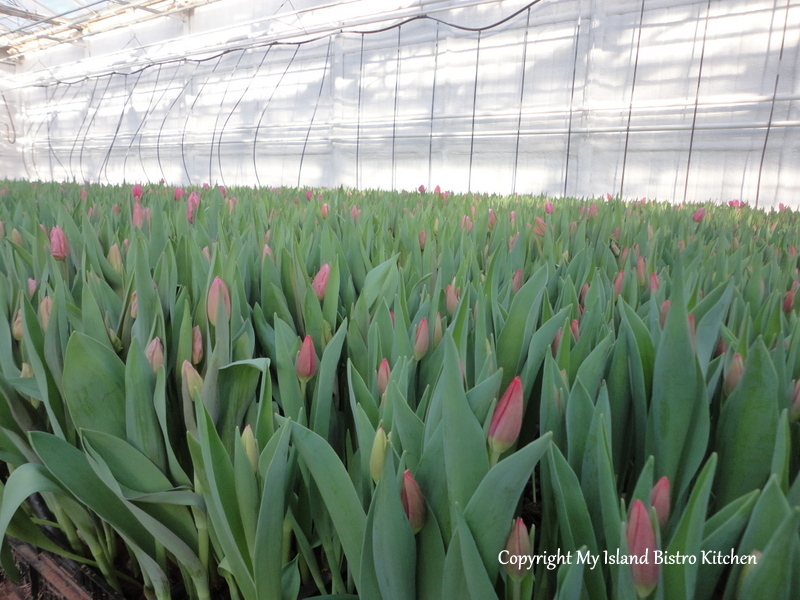
Vanco Farms began growing tulips in 2002 with a modest experimental crop of less than one acre. That venture has grown exponentially and, today, they grow some 3 million bulbs covering 40 acres – can you imagine and picture 40 acres covered in fabulous colorful tulip blooms! I asked Bas what made Vanco Farms decide to start growing tulips on PEI (they are the only commercial tulip grower on the Island). He tells me he grew up in Holland on a tulip farm that is still run by his father and sister and, when he moved to PEI, it was natural for him to grow tulips. Yes, I think it would be fair to say that tulip-growing runs through Bas’ veins and he has it down to a science. Thus, growing tulips is second nature for Bas. He says about 50% of their bulbs still come from Holland while the other 50% come from their own fields in PEI.
So, basically, here is the process. The bulbs are planted in the fields in the fall so they have a chance to root before our harsh, cold winter arrives. In the spring, once the tulips come into full bloom, the petals are all cut off the plants. The bulbs stay in the ground for about 6 more weeks when they are then harvested. The bulbs are dried and separated with the smaller ones destined for field growth the following fall and the large ones set aside for greenhouse growing over the winter.
The larger bulbs are planted in these trays in October-November and are kept in cold storage to recreate winter-like conditions for the bulbs – in other words, to trick the bulbs into acting as though it is winter.
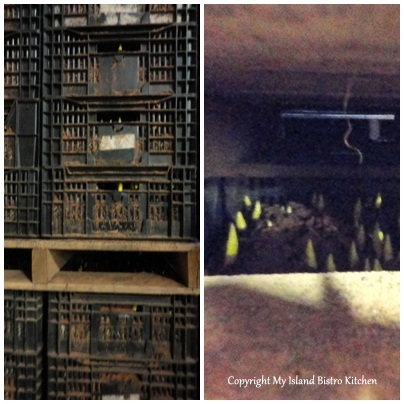
These are then moved into the greenhouse where the warmth will trick the bulbs into acting as though it is spring and time to grow. This process, known as tulip-forcing, means the tulips will be ready for market in about 21-28 days. Keeping a steady schedule of when these bulbs are taken out of cold storage at staggering times ensures there is always an abundance of tulips ready for market throughout the winter and early spring months.

When the tulips are ready for cutting, they are picked and loaded into these carts.
The tulips are then processed by this machine that cuts the bulbs from the stems. These bulbs will go into storage and be planted again next fall.
An assembly line of workers gather the tulips into bunches and place them on the conveyer belt.
The conveyer belt takes the tulips through the machine that wraps elastic around them to hold them in place.
At the end of the conveyer belt, a worker takes each bundle of tulips and slips it into a plastic sleeve.
The tulips are then placed in these crates which sit in water for about 30 minutes to allow the thirsty stems to soak up a drink.
From there, the drained crates of tulips move into a cool storage room where the bundles of tulips are packed in boxes ready for shipping.
While Vanco Farms does produce some tulip bulbs for sale, that accounts for only about 10% of their business with the remaining 90% coming from the sale of cut tulips that are grown in their greenhouses. In terms of best sellers, Bas says the most popular colors of tulips are yellow, orange, white, and pink followed by red and purple. I like them all!
I asked Bas what the biggest challenge is to growing tulips in PEI. He says our typically cold spring weather can pose an issue, particularly if there is a heavy frost. This can cause the stems to go hollow and the bulbs to not grow.
Tulip-farming at Vanco Farms is a year-round operation despite our relatively short growing season on the Island. January to May is their busiest time because it is when the greenhouse is in full production and so it is cutting season. During this time, they will employ between 15-25 people and have three delivery trucks on the road in eastern Canada and the New England area of the United States. The rest of the year is devoted to field work and processing tulip bulbs.
Vanco tulips are available at many places on the Island including the retail outlet at the farm in Mount Albion, major supermarkets, most flower shops, the Saturday Farmers Market in Charlottetown, and Riverview Country Market in the east end of the City. They also export a large portion of their greenhouse-grown tulips from January to May. In fact, their delivery trucks transport shipments of fresh tulips to Nova Scotia, New Brunswick, and Quebec twice a week and to Boston once a week.
It’s always a highlight of my winter when I discover Vanco tulips are on the market! Their colourful blooms always inject a bit of bright color into those dark, dreary winter days.
I like tulips for dining table floral arrangements. Not only do they have beautiful simplistic blooms on long elegant stems with wonderful greenery but they are also not heavily scented which means they don’t compete with food scents. There are any number of ways to arrange tulips for the dining table. Here I have selected Vanco’s Snow Lady white tulips and I simply arranged 20 of them in a fluted vase for this casually-elegant tablesetting because I was looking for something very simplistic and not fussy. I chose white because it blends in with winter and also because it matches anything. In this particular setting, I used a white tablecloth and napkins and my china pattern which is largely white. I like how the white blooms just seem to pop from the greenery! The wine glasses I chose to use are very simplistic and are actually somewhat tulip-shaped themselves. I opted to go with a plain, flat napkin fold because I didn’t want anything to detract from the tulips – I wanted them to be the focal point of the table. I also chose just a couple of small crystal votives, again so there would be nothing to compete with the floral centerpiece.
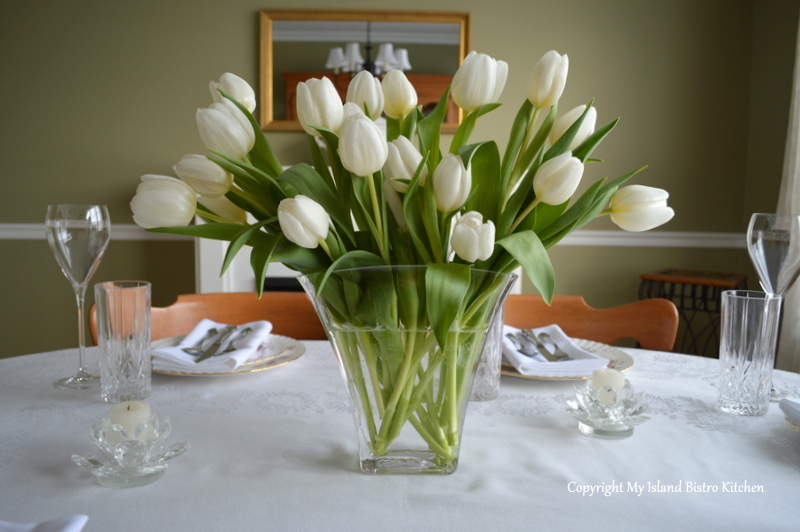
Florist Bernadette Praught of Bernadette’s Flowers in Stratford, PEI, has high praise for Vanco tulips. She says being able to go directly to their greenhouses about 10 minutes from her flower shop and pick up freshly-cut tulips means she is getting the freshest flowers possible for her customers. Bernadette says tulips are thirsty flowers and do best if arranged directly in water as opposed to in oasis arrangements. Tulips can be used in combination with other flowers and made into more elaborate arrangements. Bernadette says tulips pair well with roses and with a variety of greenery and Baby’s Breath. So, tulips are a very versatile flower. You can go with something very simple as I have done here or you can really dress them up.
For more information on Vanco tulips, visit their website. Vanco Farms Ltd. is located at 9311 TransCanada Highway, Route 1 in Mount Albion, PEI. The next time you are buying a bouquet of tulips, be sure to look at the sleeve label….you just never know, they might be ones that were quality-grown right here on Prince Edward Island!
Thank you for visiting “the Bistro” today. There are lots of ways to connect with “the Bistro” through social media:
Join My Island Bistro Kitchen on Facebook
Follow the Bistro’s tweets on twitter @PEIBistro
Find the Bistro on Pinterest at “Island Bistro Kitchen”
Follow along on Instagram at “peibistro”
Christmas Eve Tablesetting and Dinner
Sometimes, I like to glitz up my Christmas Eve tablesetting and I thought you might like to have a look.
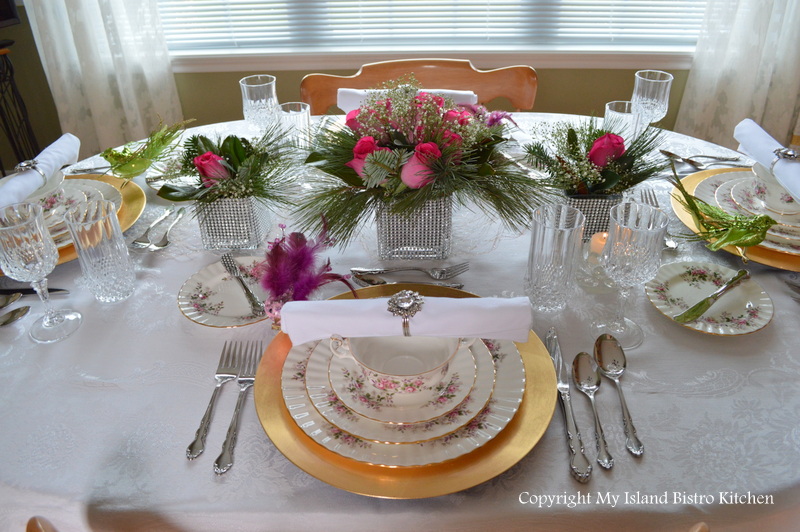
My dining table is not large but comfortably seats four and can accommodate six guests. To give an air of formality to the setting, I started out with an antique Irish linen tablecloth and chose simple gold charger plates to frame each place setting. And, of course, I used my fine china for the occasion.
For the central tablescape, I opted to go with one main floral arrangement flanked by two smaller matching satellites. Additional satellites can be added if the length of the table is greater. It’s a great way to extend the floral centerpiece down the entire length of a dining room table. The color scheme is deep rose that draws that particular color out of the darker flowers in the Royal Albert “Lavender Rose” china pattern.
Small glass cubes are very versatile standbys to have in a collection of vases. Here, I have covered them in a sparkling ribbon that shines like rhinestones. This, of course, covers up the mechanics of the arrangement (i.e., the oasis used to hold the flowers in place) and also lends an air of elegance to the table. I used lots of magnolia leaves and seasonal greens as the base for each arrangement, then the roses, and finally the frothy baby’s breath was added. Magnolia leaves are wonderful because they are deep green on one side and a velvety rusty-brown on the underside. So, you’re getting two colors and texture with one leaf!

One of the easiest ways to present napkins is in a napkin ring. Here, I have chosen a very simple napkin roll because the flowers form the focal point of the table and an extravagant napkin fold is not necessary. I found these “blingy” napkin rings a while back at our local Winners store.
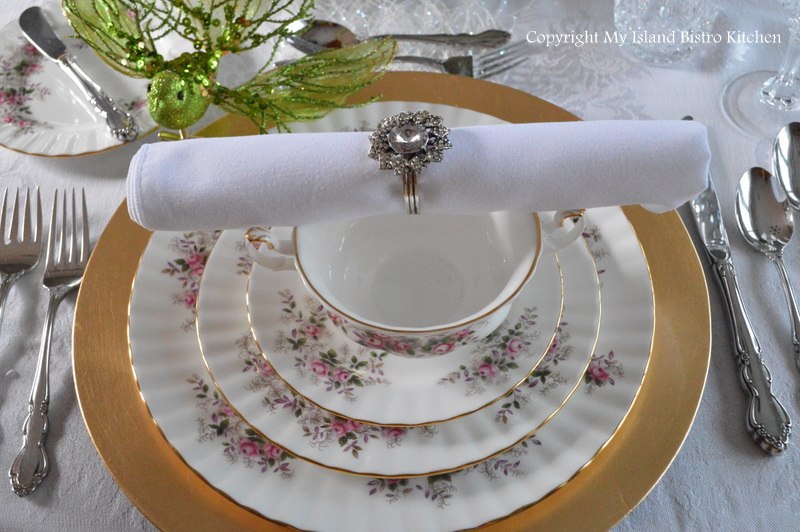
I love these wonderful little clip-on birds. I use them on trees, in mantle sprays and garlands, and even work them into place settings. So it wouldn’t appear too “matchy-matchy”, I selected two green and two pink, again to bring out the colors in the china.
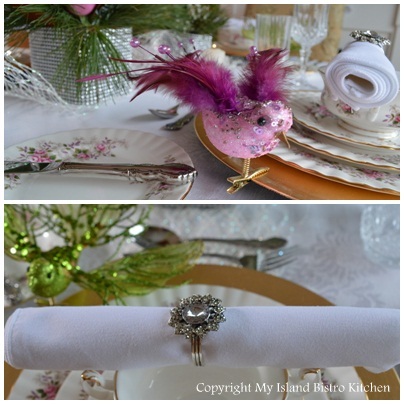
The color of these roses is just extraordinary. It’s amazing how well the rusty-brown of the magnolia leaves works with the deep rose color of the flowers.
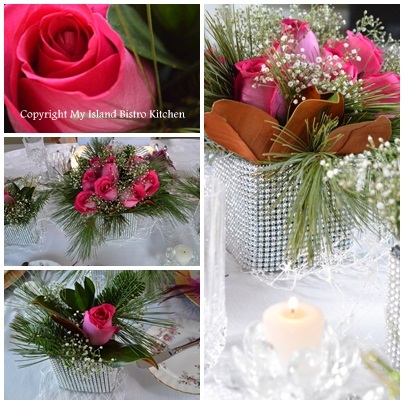
Here is an overhead view of the table. I usually line up the cutlery but, for this setting, opted to stagger the height of the flatwear.
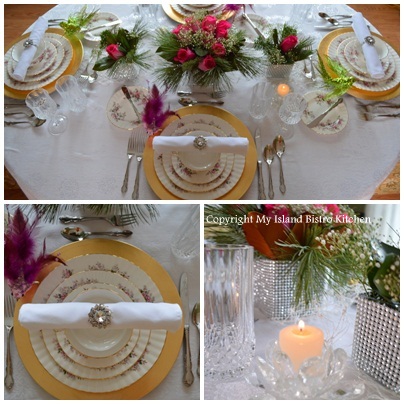
For safety reasons, I am not a big fan of using tall taper candles in tablescapes, particularly those (like this one) that will actually be used. One jerk of a knee on a table leg and a tall burning candle is easily knocked over. Generally, if my tablescape involves candles, I will choose to use low votive candles. There are many beautiful and decorative votive holders on the market and they will still give the soft glow and ambiance of candlelight and I find them safer options.
One of the things to keep in mind with any table setting is the time of day it will be used. Colors change in different lights. Some colors look great in daylight but don’t show well at night. Some will work well no matter the lighting. Here is a photo of my same table setting at night. The colors of the roses change and get a little deeper shade and everything has a warmer golden glow. I particularly like how the ribbon surrounding the glass cubes really sparkles in the glow of the evening candle light. When you are selecting the color scheme for your table setting, it’s a good idea to make sure that the colors can transition well from daytime to evening, if you are planning to use it for both.
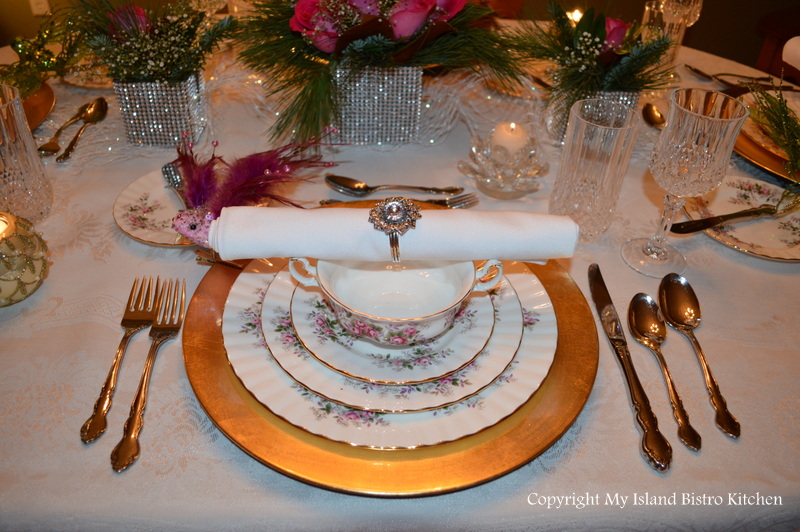
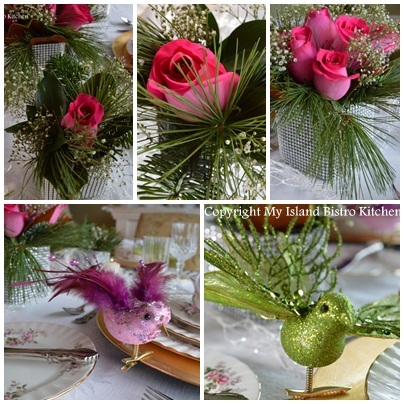
Our Christmas Eve dinner tradition is very seafood-oriented. We start with seafood chowder, then fresh Atlantic lobster with salads and, for dessert, finish with cherry cheesecake. This year, our wine pairing was Matos Chardonnay, produced from locally-grown grapes from vineyards in St. Catherine’s, PEI. You can check out my October 22, 2012, story on Matos Winery by clicking here.
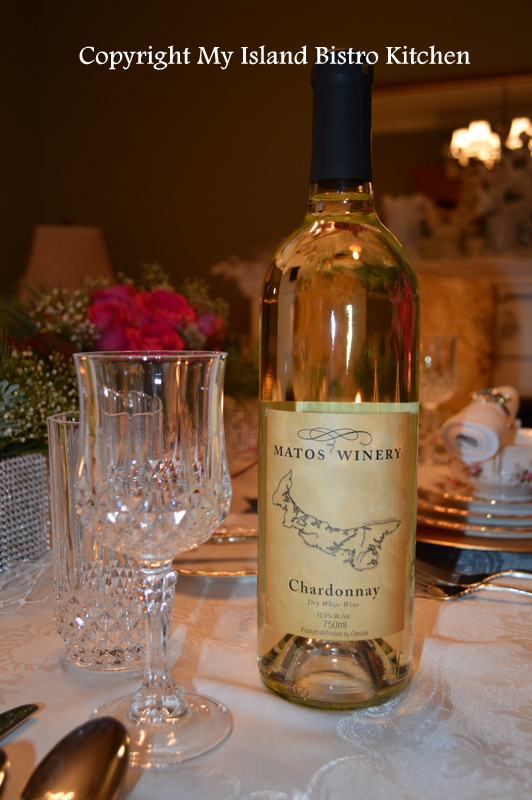
The seafood chowder recipe I used is Jeff McCourt’s PEI Seafood Chowder. You can find this recipe included in the story I wrote on September 16, 2012, following my participation in one of the culinary boot camps at which Chef McCourt taught at the Culinary Institute of Canada in Charlottetown, PEI.

How appetizing does that great Atlantic lobster look!

And, for anyone who still has room left, a piece of cherry cheesecake as a finale to Christmas Eve dinner.

Setting a beautiful table adds to the festive mood of the holiday. Thank you for visiting my blog today and enjoy this holiday season.
To view my other Christmas and New Year’s tablesettings, click on the links below:
Glitz ‘n Glamour New Year’s Eve Tablesetting
Twas the Night Before Christmas
The Warmth of the Christmas Light Tablesetting
A Tartan Holiday Tablesetting
Pretty Poinsettia Tablesetting
Poinsettia Trio Tablesetting
The Holiday Table
The Pink and Green Holiday Table
Christmas at My Island Bistro Kitchen
Purple Tablesetting for the Holidays
Evergreens and Reindeer Christmas Tablesetting
Cupcake Tablescape
Cupcake Tablescape
Cupcakes, anyone?
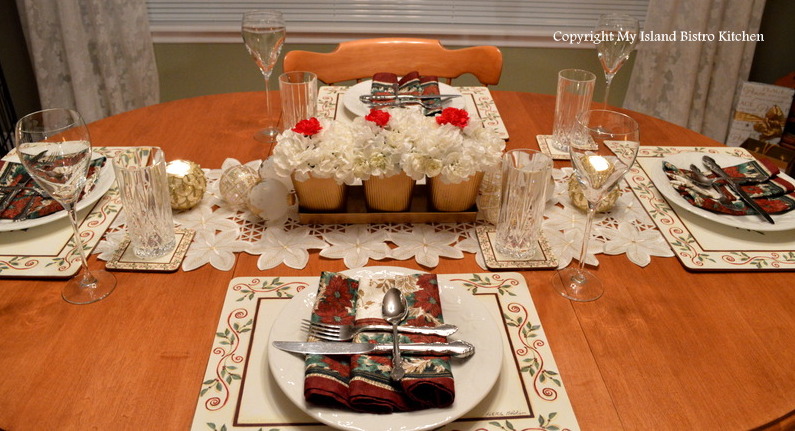
For this, my second tablescape of the Christmas season, I have opted to go with a more casual look, using everyday plain white dinnerware because it is not always necessary to have fine china in order to set a festive table. This setting would be quite suitable for weekday family dinners over the holidays or for casual dinner parties where you don’t want the look to be too fussy and overstated.
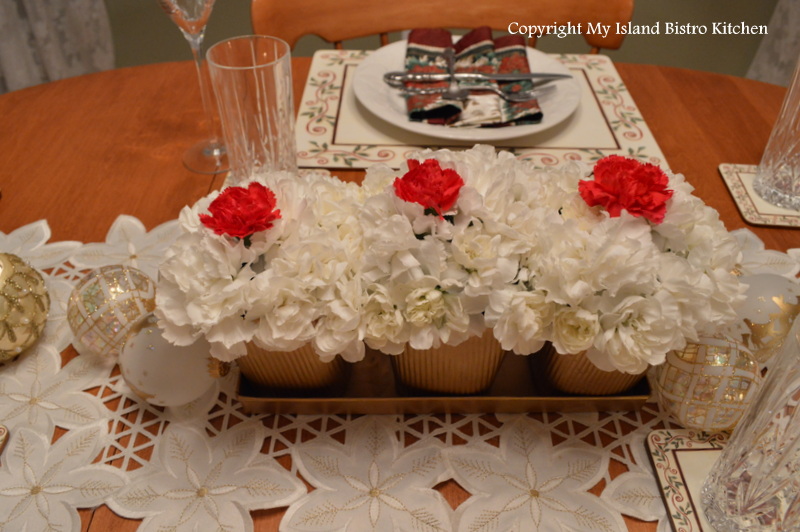
The centerpiece consists of three separate arrangements of carnations to look like iced cupcakes with a red cherry carnation on top. I have left the three arrangements together because my dining table is not large. They can, however, be separated and dispersed down the length of the table. To complete the look, I simply added some of my favorite Christmas balls and a couple of decorative votives and, voila, a simple yet attractive centerpiece.
I like these little votives for tealights. They are very versatile.
These are some of the Christmas decorations that hang on my living room tree and, of course, I always buy extras to place here and there throughout the house to tie the look together. I often use them in my holiday tablesettings.
Below is a top view of the cupcake tablescape.
For this setting, I decided to just use a runner down the center of the table instead of a full tablecloth. Keeping the wood of the table exposed lends itself to a casual setting. For each place setting, I used Christmas poinsettia placemats that work well with the poincettia-themed napkins. These hard placemats are great because they can easily be wiped off and they protect the table from hot plates. This is particularly important to consider when opting not to use a full tablecloth with a protective table pad underneath. If you are going to be serving a hot meal, I recommend these ‘board’ placemats.
Typically, I tend to use plain-colored napkins. However, because I was setting this table with plain white dinnerware, I chose napkins with a seasonal pattern of burgundy and green because there was nothing on the table that they would clash with and I thought they would add a splash of color to each white place setting. If I had used plain white napkins on a white plate that sat on a mostly off-white placemat, the placesetting would have gotten lost. The napkin fold I used is called the “wave”. It is a simple fold in keeping with the simplistic setting. It also works well with the entire tablescape which is low. I then placed the cutlery on top of the napkin, giving the setting a more informal and relaxed look.
This is a great setting to use when the event calls for understated, more casual dining.
Evergreens and Reindeer Christmas Tablescape
It’s no secret that I love setting beautiful tables! I genuinely believe it enhances a wonderful meal by providing the ambiance and it shows your guests that you put some thought and care into the dinner party. Today, I am sharing photos and a description of my Evergreens and Reindeer Christmas Tablescape.
Continue reading Evergreens and Reindeer Christmas Tablescape
Sailboat Tablescape
When you live on an Island and find yourself completely surrounded by water, it is hard not to draw inspiration from the sea for menus and table settings. In the Summer, we watch all kinds of water sports from the front verandah of the cottage and that, of course, includes colorful sailboats. It is from those sailboats that I drew inspiration for this summertime “Sailboat Tablescape”.
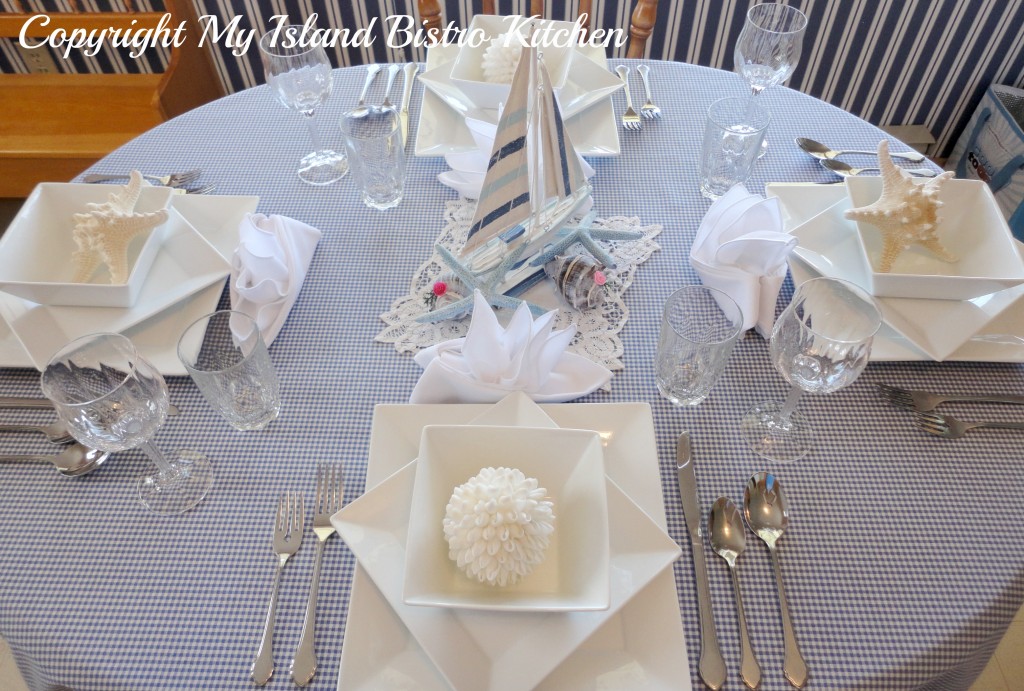
This tablesetting works particularly well in a cottage/beachside setting. Adding some interesting shells and starfish contribute to the sea theme.
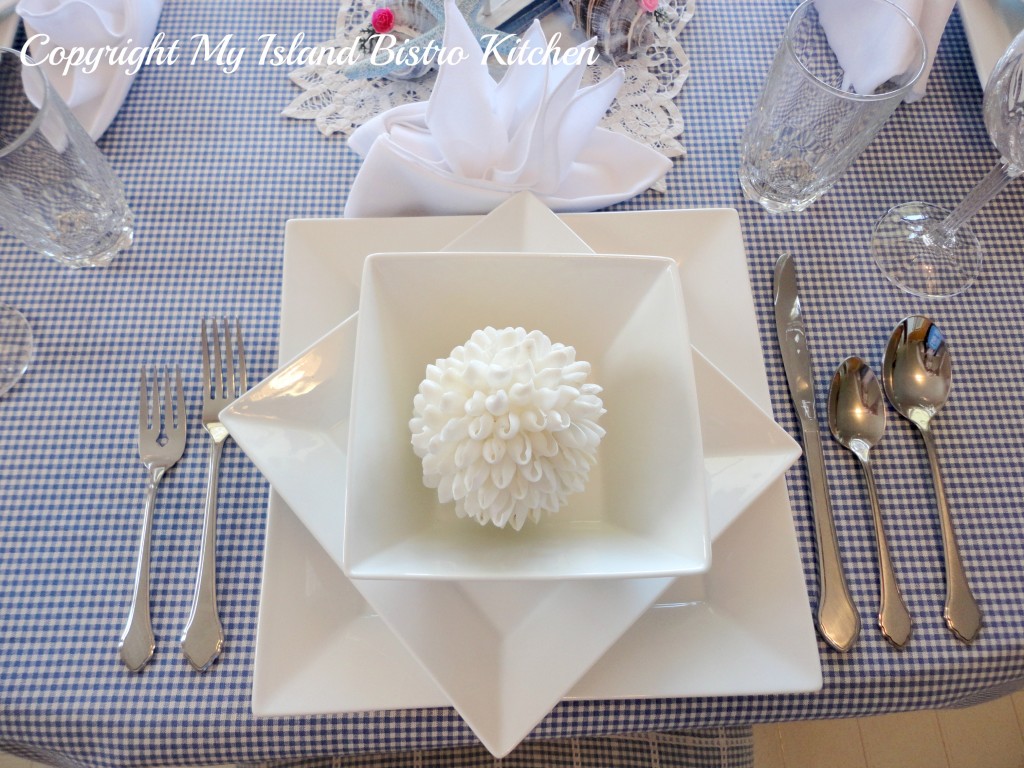
I generally prefer solid-colored tablecloths but the fabric for this blue and white checked tablecloth just spoke to me as it matched the cottage color scheme and it just seemed so “summery”!
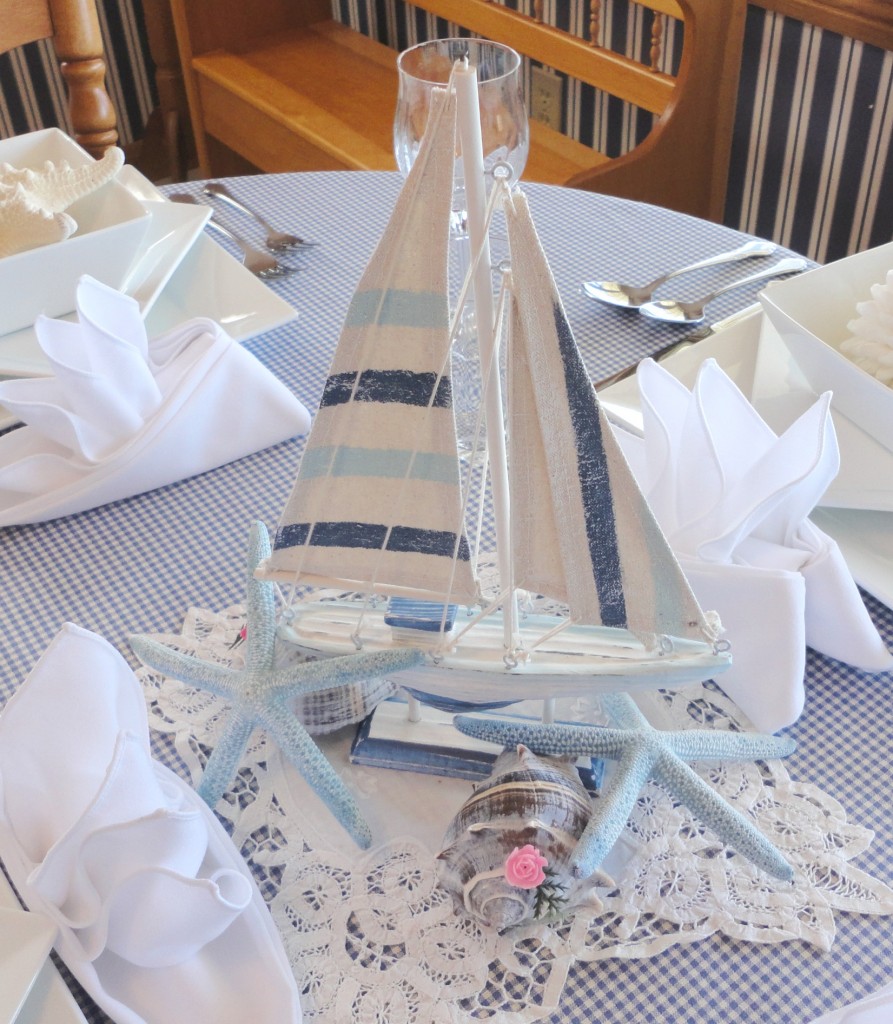
I found this wonderful little sailboat at the Wicker Emporium. Not all centerpieces have to involve flowers and this little boat with some matching blue starfish and seashells made a great conversation piece, particularly as we looked out the window during dinner and saw one just about the same color as this one sailing down the Northumberland Strait.
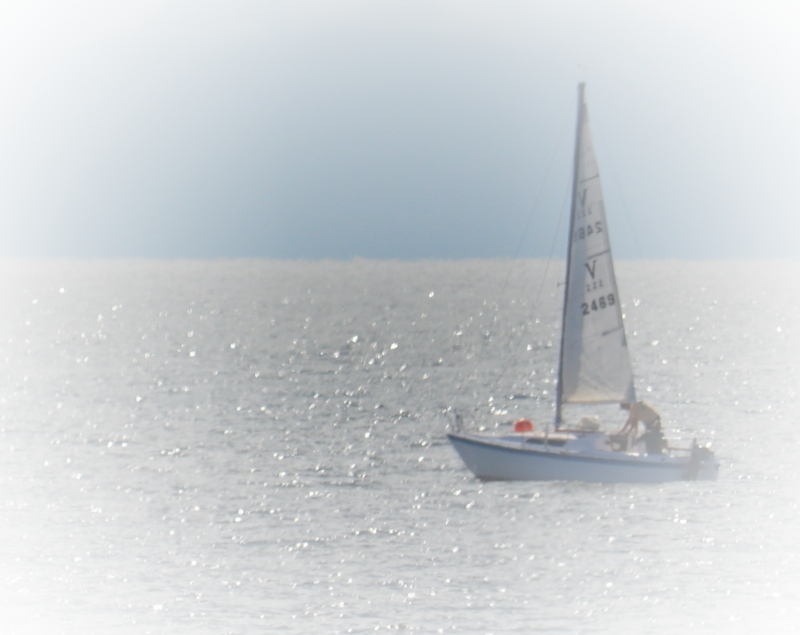

I like fancy napkin folds and try to match them to the theme of the tablescape. In this case, the sailboat napkin fold fits in perfectly with my sailboat theme! This fold always reminds of Canada Place in Vancouver, BC!
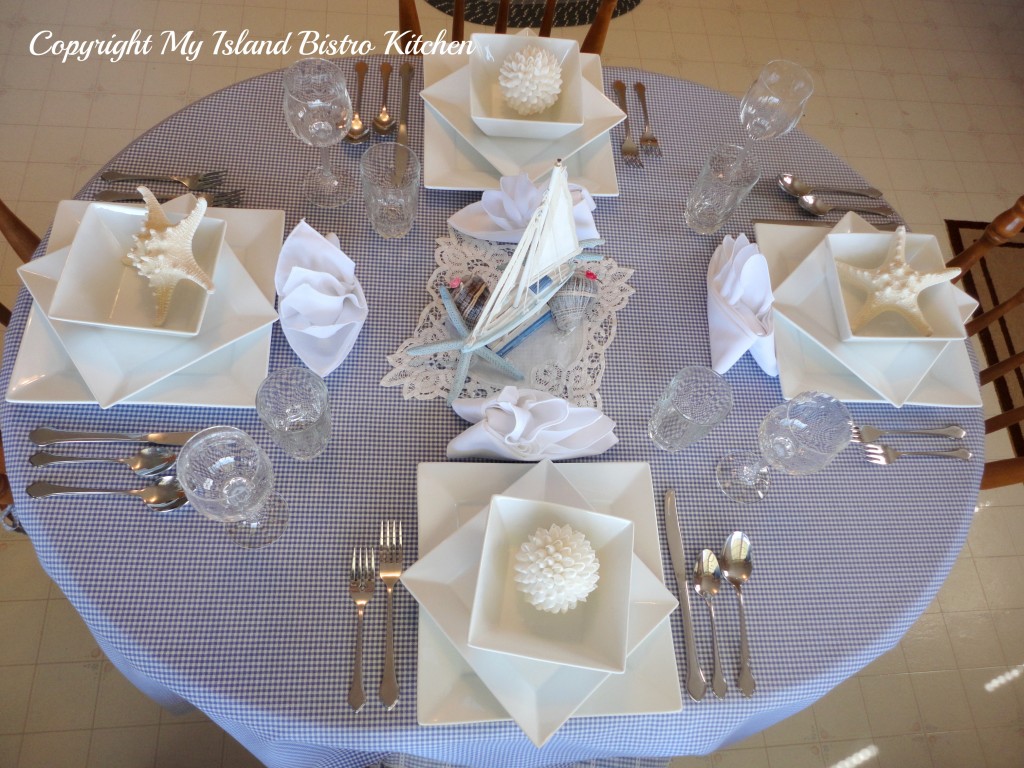
Thank you for visiting “the Bistro” today. There are lots of ways to connect with “the Bistro” through social media:
Join My Island Bistro Kitchen on Facebook
Follow the Bistro’s tweets on twitter @PEIBistro
Find the Bistro on Pinterest at “Island Bistro Kitchen”
Follow along on Instagram at “peibistro”
Floral Centerpieces with Michael Jackson of Prestige Floral Studio
[easyrotator]erc_86_1337818639[/easyrotator]
Of all the centerpieces found on dining room tables, the most common will likely involve flowers. For the low-down on floral centerpieces, I sat down for a chat with Michael Jackson of Prestige Floral Studio.
Michael, let’s start by talking about the appropriate height of centerpieces. What is considered to be the optimal height of a floral centerpiece?
Height of table arrangements should be approximately 10”-12”. The flowers should not be positioned so that they are at the height of your guests’ heads as it obstructs their view of each other. An arrangement 15” high would fall into this range.
If you are using a tall, slim pedestal container or a tall, slim glass vase and starting the floral arrangement above the 15” height point, that is okay because the tall slim container will not obstruct guests’ views of each other and the flowers will be up above their viewing range.
Does the shape of the table influence the shape/style of container and floral arrangement?
It is not set in stone but try to keep the shapes of the container and the table the same because it looks better. If you have a round table, use a round container. If your table is square, use a blocky, square container. If you have a long oval table, consider using three round containers or one main centerpiece with smaller satellite arrangements along the length of the table. If you have a long rectangular table, you may wish to consider using three to six smaller containers to extend the flowers outward from the center.
What ideas and suggestions can you give for containers a host or hostess might use for flowers?
You can invest in several different containers that can be used for different dinners. You can also look through your cupboards and use something you already have. For example, soup tureens make suitable containers. Colored bottles of different sizes can be effective containers for single blooms which can then be collected into a grouping arrangement on the table to form a centerpiece.
What considerations should one address when selecting the kind of flowers to use in a tabletop arrangement?
The first is to use unscented or very lightly scented flowers. Second, try to stay with flowers of the season. For example, tulips make a lovely Spring arrangement but are less suitable on a Fall dining table. Third, if you are using flowers from your own garden, make sure they are clean and bug-free and that any pollen has been removed.
Let’s talk about color of the arrangement. What should be matched when selecting colors of flowers? Do I match my dinnerware? For example, my china is mainly white with a border of tiny pink and purple flowers and green leaves.
Yes, match the centerpiece color to your dinnerware. In your example, your arrangement should mainly consist of white flowers with pink and/or purple accent flowers.
Other than a traditional floral centerpiece in the middle of the table, what other options are there for including flowers on the dining table?
Groupings (always use odd numbers) or multiple arrangements – for example, three separate arrangements on a long table.
Including small matching individual arrangements at each place setting is another way to disperse flowers around the table. The host/hostess can then present each guest with one of the miniature arrangements to take home at the end of the dinner.
Terrariums and low glass planters are becoming a trend in table centerpieces. They have an earthy look to them and can have thematic arrangements inside that include stones or shells, plants, driftwood, and mosses.
So, this would be suitable on a table set with earthenware dishes but perhaps not so appealing if it was set with my fine bone china with pink and purple flowers?
Correct. Be sure to match the surroundings and dinnerware.
So, what are some other trends in table centerpieces?
In the Summer, consider citrus colors – orange, lime, and lemon. You can add citrus fruits to the floral arrangement or place some on the table around the arrangement.
In the Fall, sunflowers, vases of chestnuts, acorns, grasses, and candles can be used singly or combined to make wonderful seasonal decorations for the dining table.
What suggestions or recommendations do you have for the host or hostess who wants to create his or her own centerpiece?
Go simple and use a single variety of flowers only – for example, use all roses instead of a mixed bouquet of flowers. Don’t try to do stylized arrangements and worry about getting the flowers arranged just so but don’t just stick them in a vase either. I suggest clustering the flowers together in your hand to form an appealing looking bouquet and then fitting them into an appropriate container.
Thank you, Michael, for these great tips on using flowers for dining table centerpieces. And, thank you for the stunning Summer table setting you prepared for this interview!
Michael Jackson is the florist at Prestige Floral Studio located at 595 Read Drive, in Summerside, PEI. Michael studied floral design at Humber College and worked on Toronto’s Bay Street for over 20 years designing high-end corporate and wedding floral arrangements. The lure of family and the opportunity for a floral design business drew Michael back to his native Prince Edward Island in early 2011 when he opened Prestige Floral Studio. You can check out some of Michael’s extraordinary floral designs by visiting his website at www.prestigefloral.ca.
Thank you for visiting “the Bistro” today.
There are lots of ways to connect with “the Bistro” through social media:
Join My Island Bistro Kitchen on Facebook
Follow the Bistro’s tweets on twitter @PEIBistro
Find the Bistro on Pinterest at “Island Bistro Kitchen”
Follow along on Instagram at “peibistro”
Let’s Set the Table!
In my view, there are three elements to a wonderful meal: Great food, a properly well-set table, and good conversation. In this post, my focus will be on the well-set table. For pointers on how to properly set a table, I went to the experts at The Culinary Institute of Canada, part of Prince Edward Island’s Holland College, in Charlottetown. There I was met by Tina Lesyk, Banquet and Catering Coordinator, in the Lucy Maud Dining Room, the Institute’s teaching restaurant. What follows is the substance of our conversation as we covered the gamut of topics that need to be considered in setting the proper table suitable to any occasion the home host/hostess is likely to encounter.
Types of Table Place Settings
Tina tells me there are three principal types of place settings: Formal, Informal, and Buffet. Let’s look at each one individually.

